 Crown Clade - click to expand Crown Clade - click to expand
The remaining Russulas have not been definitively separated out
into smaller groups yet, unfortunately, and there are a lot of them. Around half
of the Russulas fall into this large clade. There have been many smaller
groupings made over the years, but they have not proven to be genetically valid
groupings, so I’m going to treat them all as one large group. It gets its name
from the fact that they may represent the newest branches, at the “crown” of the
genetic tree. I also call them the “garbage” clade, since you can think of these
as species that did not end up fitting into any smaller, well defined group, but
instead got thrown in to the large garbage bin of clades. They tend to have
relatively dark, yellow spores (usually darker than the hot “core” clade
Russulas) and are mostly mild, with a few notable exceptions. The many
mild species vary a lot in their density, texture and flavour, so some make
better edibles than others. Many people indiscriminatly eat all mild Russulas
with relatively few reported poisonings, but most cannot be identified reliably
so the edibility of most species is still officially unknown. A few species,
like the shrimp Russula olympiana are popular edibles. Let's break
them down into sub-clades:
Species mentioned: Russula mordax, firmula, punicea,
versicolor, veternosa, tenuiceps, xerampelina, olympiana, viridofusca, isabelliniceps,
favrei, serissima, subrubens, elaeodes, olivacea, vinosa, occidentalis, vinososordida, decolorans,
mendocinensis, claroflava, flava, californiensis, versicolor, odorata,
puellaris, cremeirosea, sapinea, nauseosa, abietina, blackfordiae,
sphagnophila, brunneoviolacea, turci, murrillii, postiana, lutea,
risigallina, chlorineolens, chamaeleontina, olivobrunnea, olivina, intermedia, cessans,
lilacea, zelleri, obscurozelleri, pseudotsugarum, graminea, urens, cuprea,
nitida, sierrensis, velenovskyi, basifurcata, benwooi, placita, murina, inconstans,
maxima, persobria, citrina forma separata
 Hot Species - click to expand Hot Species - click to expand
Although most of these species are mild, unfortunately a few of
them are hot, making them easily confused with the “core” clade.
-
R. mordax - perhaps our most common Russula, often reddish
with a paler disc (see photo). Mistakenly called R. veternosa.
-
R. 'firmula'/'punicea' - two rare probably hot, purple, coastal spruce
Russulas
-
Russula versicolor - found under birch,
may be hot tasting in the gills and is described below under the
yellowing Russulas.
Species mentioned: Russula mordax, firmula, punicea,
versicolor, veternosa, tenuiceps
Russula mordax WA -
Arguably our most abundant Russula, found with doug fir and
hemlock, our most common trees. It is usually very acrid. The cap is reddish,
sometimes pinkish to orange, and there is usually a paler splotch of
yellow-orange in the center, unlike other species that have a darker center.
It may have a slight flush of red in the stem, but doesn’t brown very much. The odor is often
floral, also causing confusion with the “core” clade. As you can see from
the second photo, it is of course susceptible to colour variations and
unfortunately won't always have its typical colouration. We have been
calling this R. veternosa for years, a similar European species that is
actually a relative of Russula 'firmula' and Russula 'punicea',
described next. In 1936, Burlingham found and described this species from
Seattle, but it appears that nobody noticed until the study of Ben’s Russulas
revealed that more local Russulas matched this species than any other single
species, and they were all a match to the type of R. mordax, often an exact DNA
match. We wouldn’t have needed DNA studies to figure this out if we had paid
closer attention to her publications. Russula tenuiceps, an east coast
oak species, is said to be very similar (and if the same, that older name would
take precedence), but although Russula mordax has been found under oak here,
others think the species do show enough differences that they are not likely the
same. Somebody please study east coast oak specimens so we can find out for
sure. This mushroom is in the same general clade as the red-grey staining
Russula vinosa, along with a few others, but it does not demonstrate that
property, nor is it mild like the rest of them.
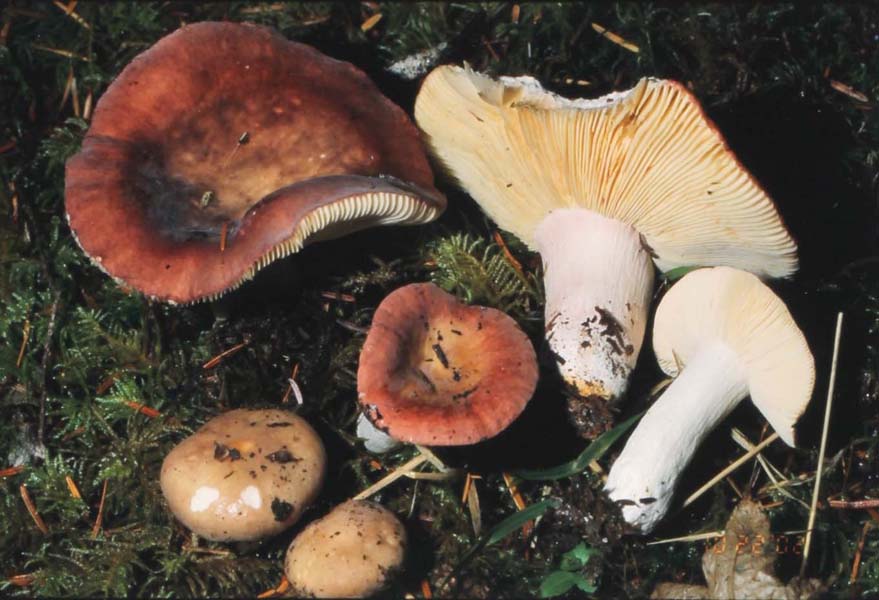

R. mordax
© Ben Woo and Steve Trudell
Russula ‘firmula Woo 55’ -
This usually hot purple Russula was found by Ben 7 times with coastal spruce,
so it very much resembles R. queletii but usually without a prominent
flush of purple in the stem. It has much darker yellow spores. Then it
was found once with spruce in Idaho (so much for its identity as a coastal
species) The ID collection was unfortunately mild tasting and pale capped,
further complicating its identification. Our local
species is about 2% different in DNA than the European R. firmula.
Russula ‘punicea’ CA -
This fairly rare (up north in the PNW) related wine
coloured Russula (from the same hot tasting clade in the Crown clade
as R. firmula and R. veternosa, the species that R. mordax
was long mistaken for) is also found with spruce on the coast and usually
has a prominent stem flush like R. queletii, but it usually is redder than
it and R. firmula (again, with darker spores than R. queletii). It was described
from California in 1997, but unfortunately the name R. punicea was
already taken back in 1945, so it needs a new name. An attempt to sequence the
type failed, but collections from the type area of coastal CA match a recent
coastal spruce OR sequence and two Ben Woo sequences from coastal WA and OR.
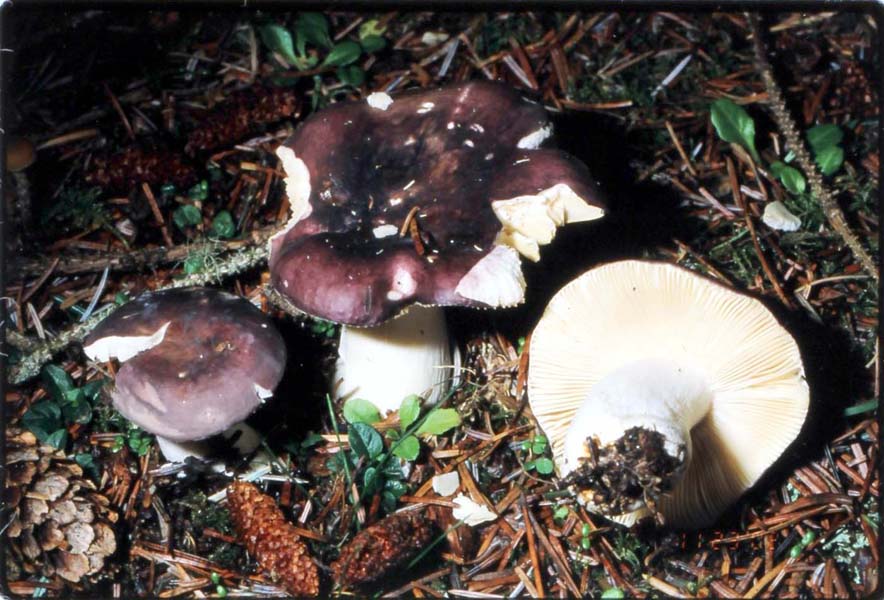




R. ‘firmula Woo 55’
© Ben Woo and Krista Willmorth (2 images), R. ‘punicea’ © Ben Woo and Ann Goddard
|
 Shrimp/olivacea Russulas - click to expand Shrimp/olivacea Russulas - click to expand
First, the shrimp Russulas.
These are some of the most popular edibles in Russula, probably
because they are easier to identify than most, not because they are the best
tasting. They are not as dense and well-textured as some other species, but the
shrimpy-ness disappears in cooking. The cap can be many different colours, but
the following combination of characters identifies them:
-
large, mild tasting Russulas. In the “crown”
clade; the only other Russulas to regularly get >15cm across are R. vinosa< and
R. benwooi.
- they smell like shrimp, at least in age
-
a drop of FeSO4 turns them green, which doesn’t
usually happen in any other group.
-
the flesh is especially susceptible to browning
-
the stems are sometimes flushed pink
-
the spores are rather yellow so the gills are quite
yellow in age
Also in this section I discuss our local species that resembles R.
olivacea, which differs in significant ways.
It is quite dense and is probably one of the best edibles in the genus.
-
does not smell like shrimp, does not turn green in FeSO4, does not brown
much, and is much denser. It's cap is usually purple and/or green.
It is also large with the stem significantly flushed with red/pink.
Species mentioned: Russula xerampelina, olympiana, viridofusca, isabelliniceps, favrei,
serissima, elaeodes, olivacea,
subrubens
Russula olympiana WA (Russula
xerampelina EU misapplied)
-
Woo 61. Our abundant species is significantly different genetically than the
European Russula xerampelina EU, so it finally got its own name, although I do not yet know of a way to
separate them other than by country of origin and genetics. It is usually
wine coloured (some shade of purple, red or both). The stem is often
flushed with pink. It is usually found with the typical Doug fir and
hemlock and other conifers. Since this can be one of the easier groups of Russulas
to identify, it is a popular edible. Unfortunately, sometimes it can be almost
any colour, as seen in the second brown photo, where it could easily be confused
with our 2 brown species.


Russula olympiana
© Ben Woo
Russula viridofusca WA
-
This shrimp Russula is also found with different conifers but is
usually pale pinkish-tan, pale yellowish-tan, or pale greenish-tan and has little stem flushing.
It can be green or even reddish and so probably can’t be unmistakenly
differentiated from the others. It was originally proposed as Russula
xerampelina var. isabelliniceps in 1965 by Grund who ended up describing it
as R. viridofusca,
from Washington in 1979. It is very common,
collected by Ben more often than R. olympiana (31 vs 13 times), but that may
be because he didn’t feel the need to sample the latter very often. We have the
ITS1 sequence of the type, and longer sequences matching it.

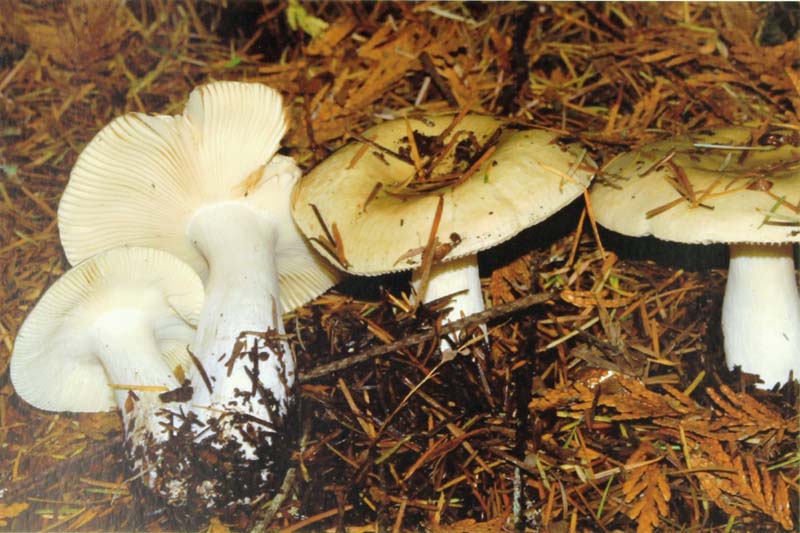
Russula viridofusca
© Ben Woo (2 images)
Russula serissima MA (=Russula favrei EU,
Russula 'elaeodes' EU misapplied) -
We have been calling this
species Russula elaeodes, but that
species is probably the same as R. pseudoolivascens and R. clavipes, which turns
out to be something different. This is another case where there were similar
lookalike European species, and somebody chose the wrong one as our local
species. Our species matches a pretty unanimous consensus
of what the European R. favrei is, found with conifers. Then it was
discovered that the older Russula serissima MA was the same thing, so
that is the proper name. Here it might prefer
hemlock and spruce. Its colour scheme is usually brown with an especially
dark brown center. It has little stem flushing just like R. viridofusca. Perhaps it
can have purple tones like R. olympiana so it also may not always be easy to
distinguish.
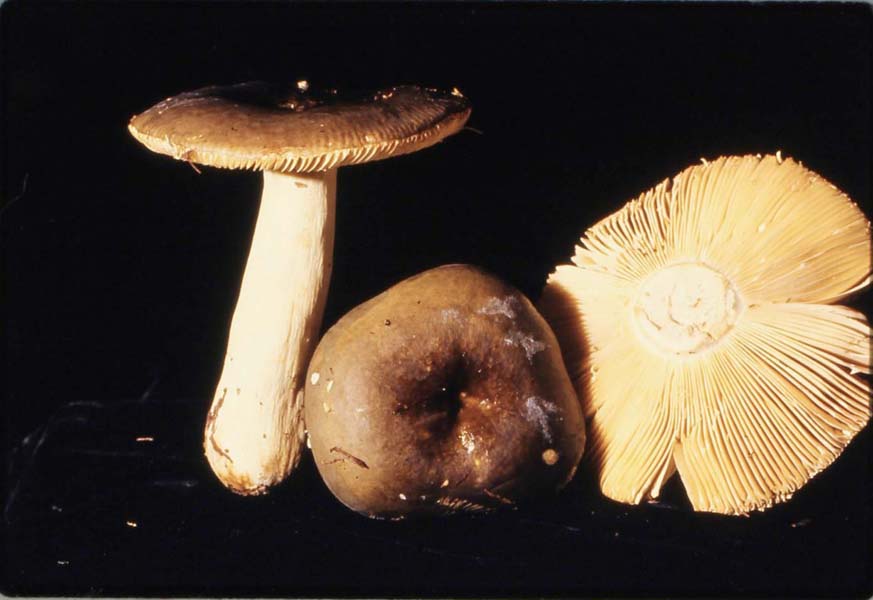
Russula serissima
© Ben Woo
Russula subrubens EU - one
single OR coast collection with a yellow cap matches dozens of EU sequence of
R. subrubens. It is a willow species from dunes near the coast or from
arctic/alpine habitats in the EU. It is described with a red cap,
although ours had no red in it, and was found under California bayberry. If it
does occur here with a red cap too, it might look like Russula olympiana,
but this species seems to have no flush of colour on the stem. It has also been found
in CO and MT.
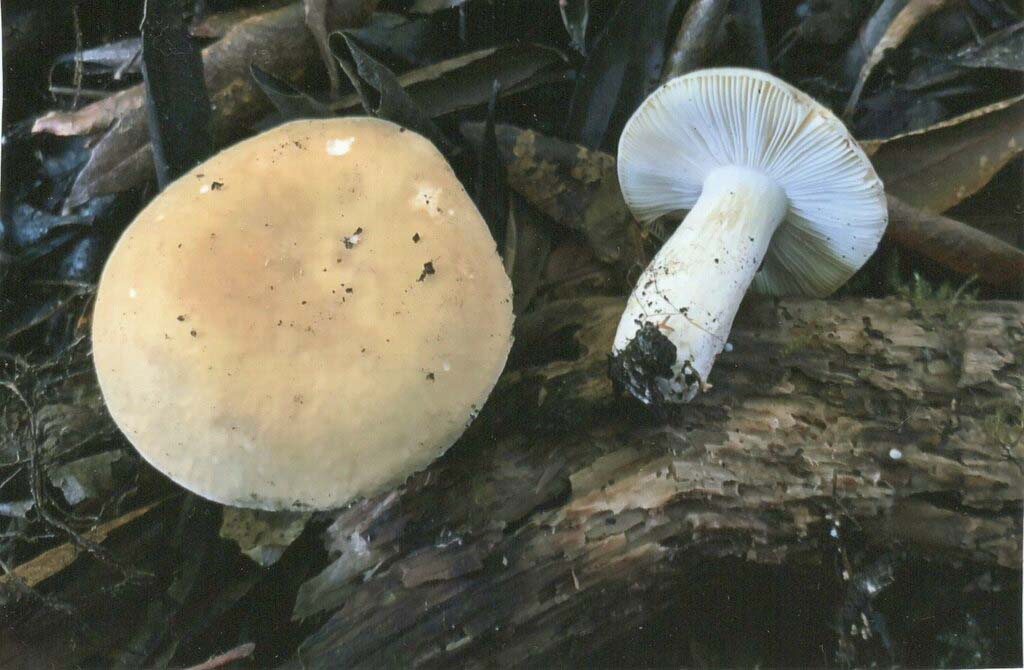
Russula subrubens © Buck McAdoo
Russula 'olivacea Woo 58'
-
This is not a shrimp Russula, but it shares some features. It’s
large and has a stem flushed with pink with fairly dark yellow
spores. But this is an especially dense Russula (so some say it is
one of the best edibles but others caution about possible poisonings), with a
somewhat velvety purple and/or green cap that has a very interesting
texture when fresh. It
does not smell of shrimp. It does not usually brown as much as the shrimp
Russula and FeSO4 will not usually turn it green, but both of
those are variable features as I have found one collection that browned
significantly and did turn green in FeSO4. It turns out we
do not have the real R. olivacea here, but a sister species. It will need
a new name. It is uncommonly found with conifers like Doug fir, hemlock and spruce.



Russula 'olivacea Woo 58'
© Ben Woo (2 images) and Fernando Macias-Jimenez
|
 Greying Russulas - click to expand Greying Russulas - click to expand
Some Russulas with brightly coloured caps will turn grey after
you scratch the stem (as the white Compactae group
can). They might also turn reddish before turning grey. Three separate
clades have species that behave this way (although not every species in the
clades exhibit this feature).
Species mentioned: Russula vinosa, occidentalis, vinososordida, decolorans, mendocinensis, claroflava, flava, californiensis
Clade 1
Russula vinosa EU (=R. occidentalis)
-
another large Russula
with olive colours in the center
and purple colours on the edges (or perhaps either one of those colours).
The spores are a only faint creamy yellow, not as dark as many in the
crown clade. Scratch it and wait a few minutes to a few hours) and it will turn
reddish and then grey. Russula vinosa was described from Europe and then our
west coast species was later considered a variety of that mushroom, eventually
getting a promotion and getting its own name, Russula occidentalis. Anna’s study
showed that there is very litle genetic difference between our species and the
original R. vinosa (perhaps 2 differences or so on average) so if that and the
macroscopic differences are not considered enough to justify a separate species,
ours would just be considered R. vinosa. It is found with various conifers.

Russula vinosa (occidentalis)
© Ben Woo
Clade 2
Russula 'vinososordia Woo 57'
-
This large Russula (and a couple other species) are not in the same clade as R. vinosa, and represent a separate
genetic lineage that stain similarly red/grey. It is
uncommonly
found with various conifers, but differs by usually having orange colours
and a dark yellow spore print. When bruising is noted, sometimes a red
stain is noticed before a grey stain, but sometimes only the grey staining is
noticed.
There are two European Russulas that match this description, R.
decolorans (in clade 3, a Fries species from 1838) and R. vinososordida
(from 2000, recently discovered to be a lookalike). Before 2000, it was assumed,
of course, that all our specimens were R. decolorans (the only known
species at the time). After 2000, nobody thought to check to see which species
ours was. This study has shown that all 10 of Ben's PNW specimens matching this description are
1% different than the type of R. vinososorda, but not at all close to R. decolorans.
This is probably a little too reliably different genetically to be considered to
be R. vinososordida - a similar
1% difference separates the very different looking R. mendocinensis from both species.
Also, our species is a conifer associate whereas R. vinososordida is a
hardwood associate. It should be noted that R. decolorans has since been
found in Alaska, and now recently in Vancouver BC, so both species do occur
here, supposedly easily separable microscopically. Perhaps the confusion in the
past was due to our local species being a conifer species like R. decolorans
instead of a hardwood species like R. vinososordida.
Russula mendocinensis, as I stated, is a closely
related mixed conifer-hardwood forest species (I’m not sure which trees it
actually grows with) in California that can look and act surprisingly diverse.
The type was purple, staining orange (but greying was not noticed), and was
supposedly quite acrid tasting. However, a mushroom very much like R. vinososordida
from CA sequenced to be
R. mendocinensis instead, so it may not always look different than R.
vinososordida. This will have to be looked into. R. claroflava (=R. flava),
a bright yellow mushroom that stains reddish then grey, not yet known from the
PNW, has been reported from here before but could represent sightings that were
actually “aff vinososordida” or perhaps Russula sp. Woo 65. Russula flava var
pacifica was described from Oregon, but it is
clearly not a variety of R. flava, but very likely actually a “core clade”
member, as stated on those pages. Save any yellow specimens you find that stain this way.
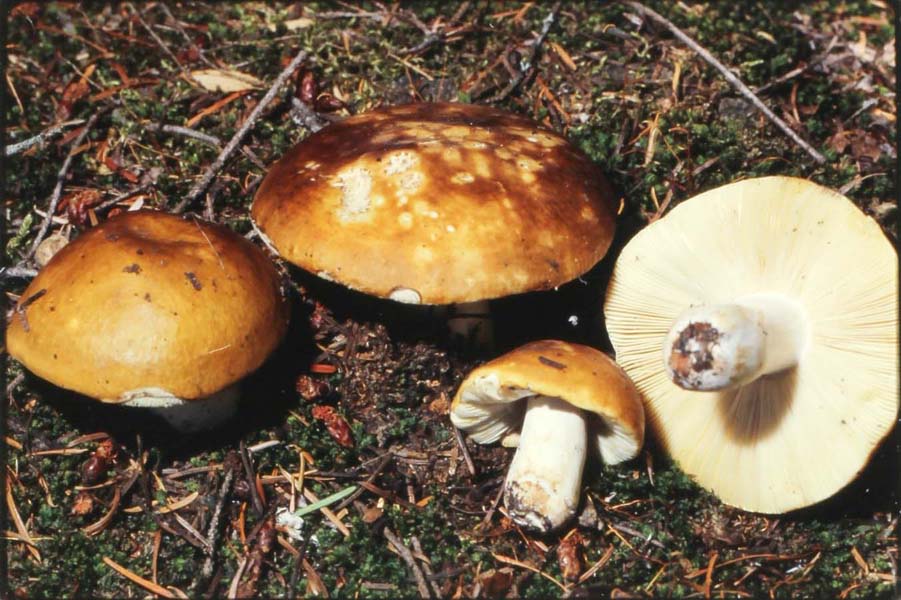
Russula 'vinososordia Woo 57'
© Ben Woo
Russula 'californiensis Woo 56'
-
Russula californiensis CA is a California pine species that is
rosy red with a greying stem and mild taste. Our species is different and
probably needs a different name (at least 6 substitutions and 2 indels different
in ITS2, or >1.5%). It is rare, having only been found once with conifers (not pine) near
Snoqualmie Pass WA, and was pinkish/rosy red with some greyish yellow tones.
Although the greying in age or when damaged wasn’t specifically noted, it
probably does. It was mild with creamy spores.

Russula 'californiensis Woo 56'
© Ben Woo
Clade 3
Russula decolorans EU -
while all of Ben's orange Russulas that eventually stained grey (often
turning red/orange first) turned out to be Russula aff. vinososordida
and not Russula decolorans, we did later find R. decolorans
in Alaska, northern BC and now finally in Vancouver BC and Oregon, so it is here too. It is
probably also a conifer species. The
two are supposedly easily separable microscopically. Perhaps the confusion in
the past was due to both local species being conifer species like R.
decolorans instead of hardwood species like R. vinososordida.
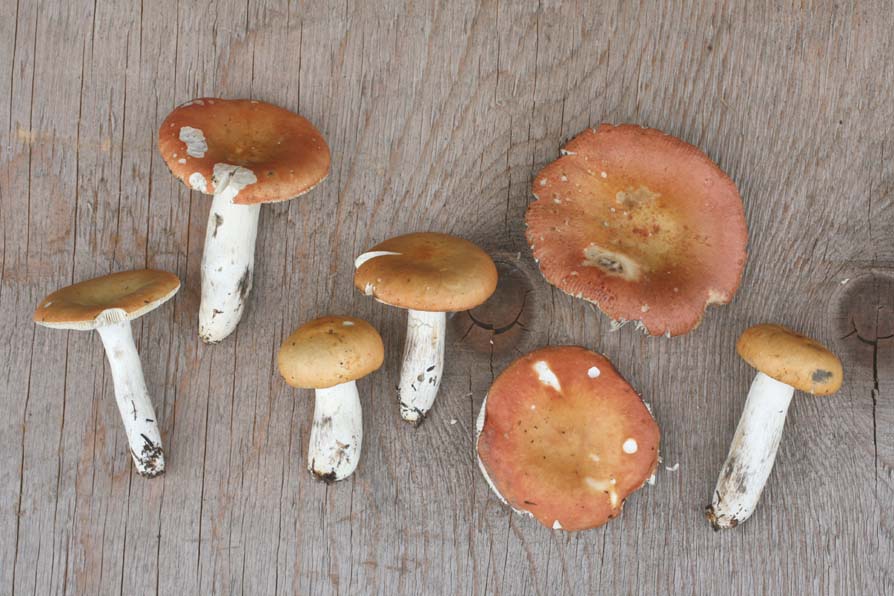
Russula decolorans © Marty Kranabetter
|
 Yellowing Russulas - click to expand Yellowing Russulas - click to expand
Some Russula stems and other fleshy parts will turn a fairly
bright yellow in age. They seem to make up a good sub-clade of related
species, although not every species in the clade may exhibit the yellowing
staining very easily.
Species mentioned: Russula versicolor, odorata, puellaris,
cremeirosea, sapinea, nauseosa, abietina, blackfordiae, sphagnophila,
brunneoviolacea
Russula versicolor EU -
The colours can be quite variable as the name suggests (usually with
purple, red or maybe green), but careful attention to an admittedly
slight stem yellowing can help identify it. Also,
this is the only yellowing species group that is acrid tasting, especially in the gills.
What is probably the real R. versicolor,
under birch, is uncommon here.
Russula 'versicolor Woo 44'
- Less uncommon is the sister species, Woo 44, usually found under cottonwoods but also
under birch. Two
Seattle specimens of the "sister" species were found under cottonwood
instead of birch, one Seattle collection was found with birch, and one northern BC collection was found with conifers.
This species has 2-3 differences and 1 indel in ITS2 and a further 4 differences in ITS1
from sequences of R. versicolor itself. DNA matching this sister species is found all over Europe with the "real"
R. versicolor as well, so the species are not distinguished by geography.
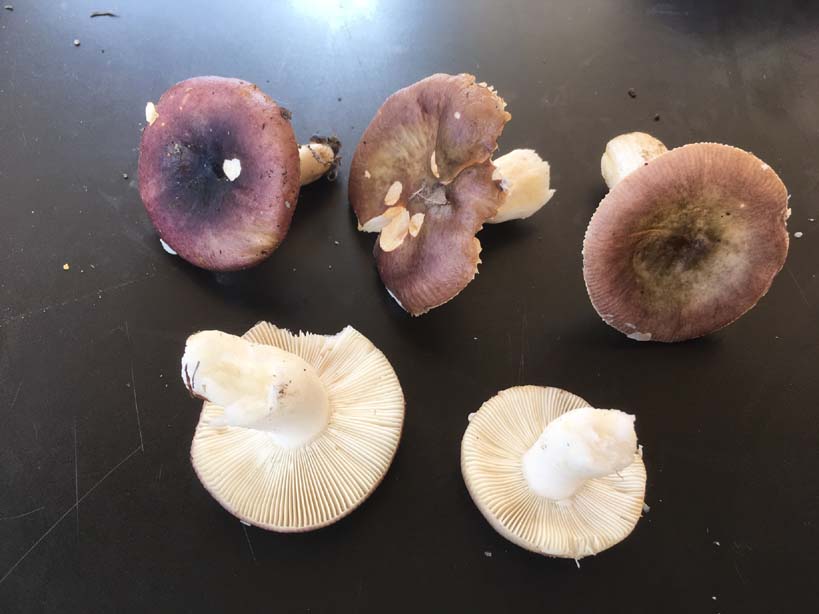
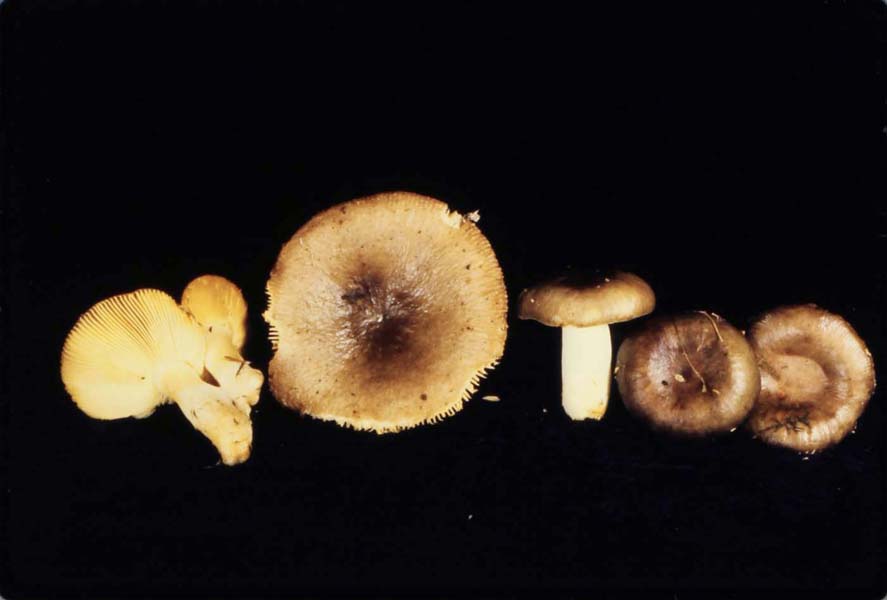
Russula versicolor
© Danny Miller, Russula 'versicolor Woo 44' © Ben Woo
Russula 'puellaris Woo 42'
-
This is the rarest of three similar species in the yellowing
clade, found once on Washington’s Olympic peninsula near conifers (spruce,
Doug fir, hemlock and cedar), once on the Oregon coast west of Eugene and once
in OR near Mt. Hood. Yellowing was not noted in the notes, but you can
see yellowing in the first photo.
This group of mushrooms have previously gone under
the name Russula puellaris. That similar, closely related European
Russula was thought to be our local species until these studies have
revealed differently. Woo 42 is about 3% different from R. puellaris, probably
enough to justify it being a different species. It is also about 3% different
from R. cremeirosea. This first collection appeared to have more red tones
than purple tones (although the colour was bad), but the second collection was
purple with a darker disc just like the other 2 species.
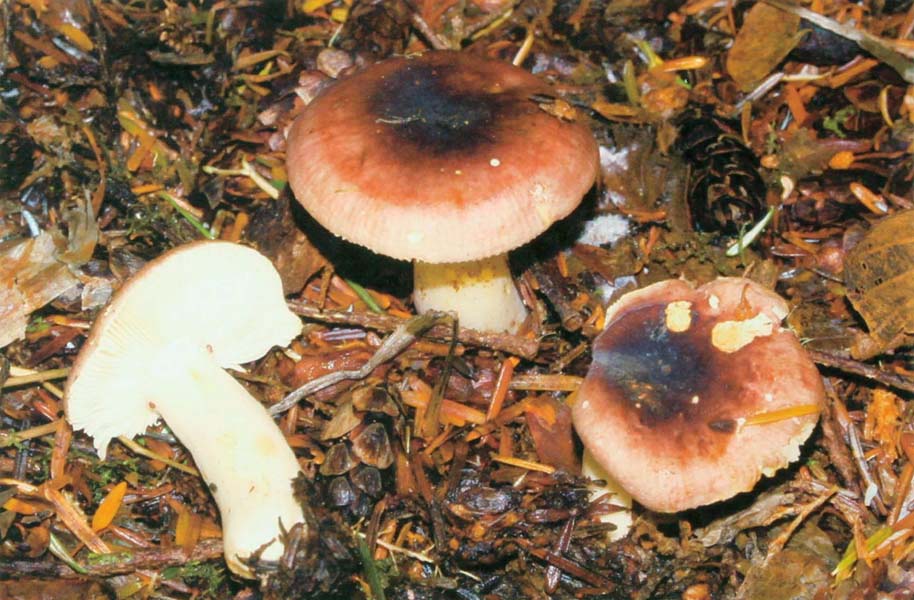

Russula 'puellaris Woo 42'
© Ben Woo and Ann Goddard
Russula ‘sapinea Woo 43’ -
Most yellowing Russulas in the PNW are this
common one and the next
one. This may be Russula sapinea EU, which is not known to turn
yellow over there, but it does over here, so it should be more closely examined
in Europe. The genetic variation is a bit high in sequences of this species (up
to a full %), but without forming any groups, so I think it may just be all one
species. It’s possible somebody will find a reason to split it into more than
one species in the future. It is usually purple, but can be red-purple or
closer to red like the previous species. Many different conifers were around
when it has been found. Rumours of R. nauseosa being in the PNW are
probably not true. I don’t even know if that European species is in the
yellowing clade or in the R. zelleri group (found on the "zelleri group" page), but whatever it is,
it’s not actually here.

Russula 'sapinea Woo43'
© Ben Woo
Russula 'abietina Woo 45'
-
This is the other common species.
R. abietina was described from NY as being like R. puellaris
except for not staining yellow. There is some confusion over what R. abietina
really is. A study of Peck’s type collection in 1947 gave Singer the impression
that it was just a mixture of the existing species R. blackfordiae and
R. sphagnophila. If R. abietina truly was a new species, the Russulas that
seem to be what Peck described have turned out to be one of two things. Firstly,
this mushroom, that perhaps doesn’t always turn yellow in age or maybe the
yellowing was not always noticed. When collected here, it’s usually noticeably
yellowing. When collected in Tennessee, yellowing has mysteriously not been
noted. You might expect to find the same species in New York as you do in
Tennessee, so perhaps this mushroom is R. abietina. Secondly, it might be a
mushroom in the Russula zelleri group (see that page). These were collected in
California, I believe, which may or may not have the same species as what is
found in New York. The aforementioned R. blackfordiae, R. sphagnophila and also
R. brunneoviolacea are three poorly understood Russulas with dubious
reports from the PNW, which this study can somewhat debunk. It is not even
certain if those species belong in this clade, the R. zelleri clade, or the
shrimp Russula clade. I’m going to take a guess that perhaps R. abietina is this
mushroom in this yellowing clade, but all we can say for now is that it looks
like it superficially, so thus my calling it “cf” abietina. To prove it,
somebody will need to study the NY type, if available, and/or a number of
matching collections from the New York area. Unfortunately, as far as I know,
this mushroom looks identical to R. sapinea. The microscopy should be examined
to see not only if this species could in fact be R. abietina, but if it can be
told apart from R. sapinea and R. sp. Woo 42 (aff puellaris). This species is
another conifer species.
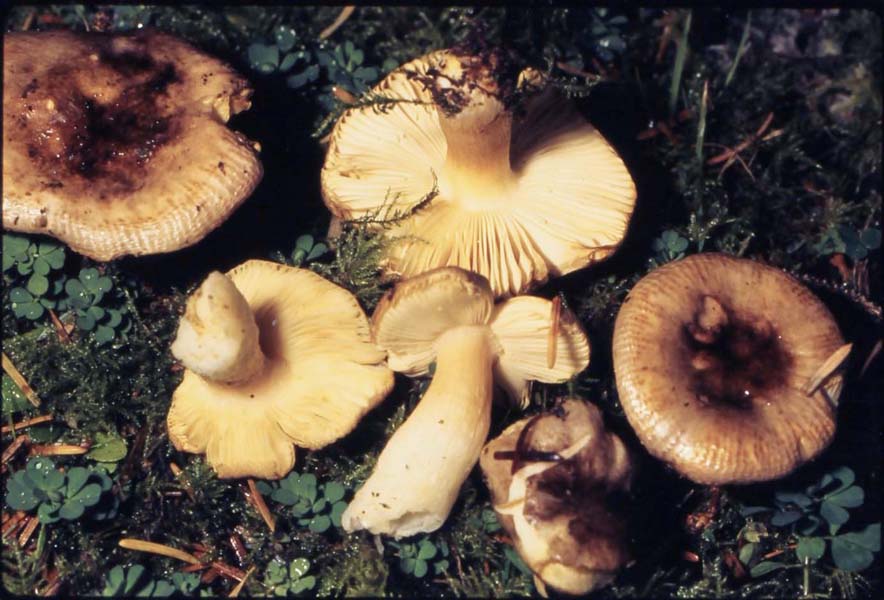
Russula 'abietina Woo 45'
© Ben Woo
|
 Encrusted Cap Hyphae (matte purple caps) and Cream/Yellow Russulas - click to expand Encrusted Cap Hyphae (matte purple caps) and Cream/Yellow Russulas - click to expand
-
These purple (or reddish-purple) members have
pruinose or matte purple caps, the texture you often see in the
Heterophyllidia clade, but they are more fragile and less dense, with
darker yellow spores. Microscopically, you can identify the reason for
the pruinose cap by finding “encrusted pileal primordial hyphae”.
Pileal means in the pileus cuticle, the top layer of the cap. They are
crusty bumps on the walls of otherwise cylindrical cells, a few of which are
pointed out in the micro photo under Russula 'murrillii' below.
-
In this section I also cover
yellow Russulas that may or may not have the encrusted cap hyphae -
but even if they do, they do not demonstrate it with a matte/pruinose cap
texture; they usually have regular, somewhat shiny caps.
Species mentioned: Russula turci, murrillii, postiana,
lutea, risigallina, chlorineolens, chamaeleontina, olivobrunnea, olivina, intermedia,
basifurcata
Note that Woo 16 in the Heterophyllidia has a pruinose purple cap that seems to be
more likely to fade, and perhaps has a stem flushed with purple and denser flesh.
Russula ‘turci’ (Woo 72) EU -
This is the most abundant of the three local species, a European
species found under various conifers that sometimes has an odor of iodine
in the base of the crushed stem. The caps are most often dark purple, but
may occasionally have some red tones or even have faded to yellow-brown.
If any of the three normally purple species have faded to yellow, they could be
confusable with the unrelated conifer species R. olivina, below. But if you
look carefully at the caps of a fresh specimen (or under a microscope), there is something special about that “matte”
appearance, an almost powdery look that makes this group especially beautiful,
especially when dry, due to encrustations on certain cells in the cap cuticle.
Species in the EU labelled R. turci make up as many as
three different species, and without a type sequence, we don't know for sure
which species is the real thing, but ours most closely matches a consensus of
what probably is the real one. The genetic variation found in our local species
(about 5 bp
differences in ITS between us and Europe) is not necessarily enough to justify considering ours a
separate species. An unusual amount of genetic variation in this species and R. murrillii has been found, possibly indicating that some kind of evolutionary
pressure is currently causing speciation. Perhaps we are witnessing the
formation of new species, and eventually, they will sort themselves out into
distinct clades with further distance between them.
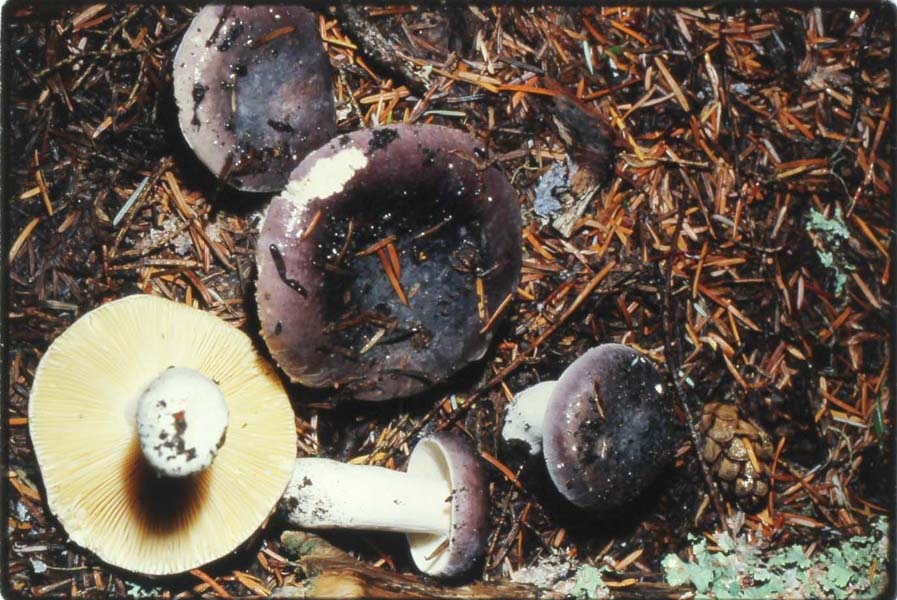

Russula ‘turci Woo 72’
© Ben Woo, uncommon yellow form
© Ben Woo
Russula sp. Woo 71 -
This very closely related species cannot yet be told apart from
R. turci. It is rare, found by Ben 3 times in WA near Glacier Peak with fir, Doug fir,
hemlock and cedar nearby. Twice it was deep purple like R. turci, but once it
had red tones like R. murrillii more often does, below. It has since been
found once near Vancouver, BC.
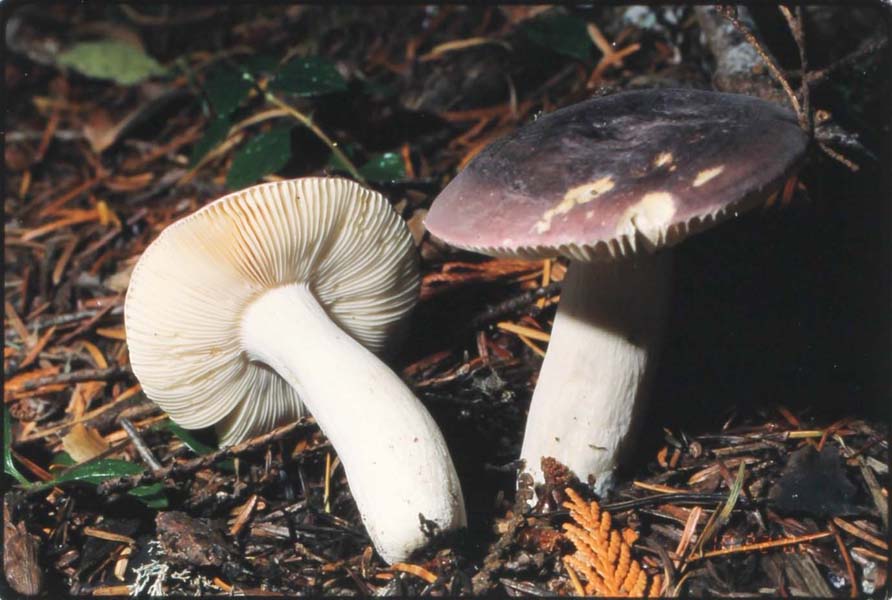
Russula sp. 'Woo 71’
© Ben Woo
Russula ‘murrillii’ (Woo 70) OR
-
In 1913, Burlingham described
this fairly common mushroom collected by W. Murrill in Corvallis, OR under conifers. She
didn’t directly compare it to R. turci, but others soon did, and recognized it
as a related but separate species. This species is more often reddish-purple
than R. turci is (but might also be deep purple or yellow-brown), and
reportedly lacks the
iodine odor that R. turci sometimes has. The caps may not be as obviously pruinose as
R. turci, and the
stature is usually a bit smaller.
I don’t have type sequences of either
species, but many sequences of specimens from the type areas of both species are
consistent with each other so there is a consensus of what represent these
species. However, the descriptions of this species and R. turci seem somewhat
switched with each other which I can’t quite explain. The description for R. turci says it’s often wine coloured and the description for
R. murrillii is
supposedly almost always pure violet, but dozens of collections I've examined
show the opposite is true. I await type sequences or some official
decisions being made to make sure I have our species names correct.
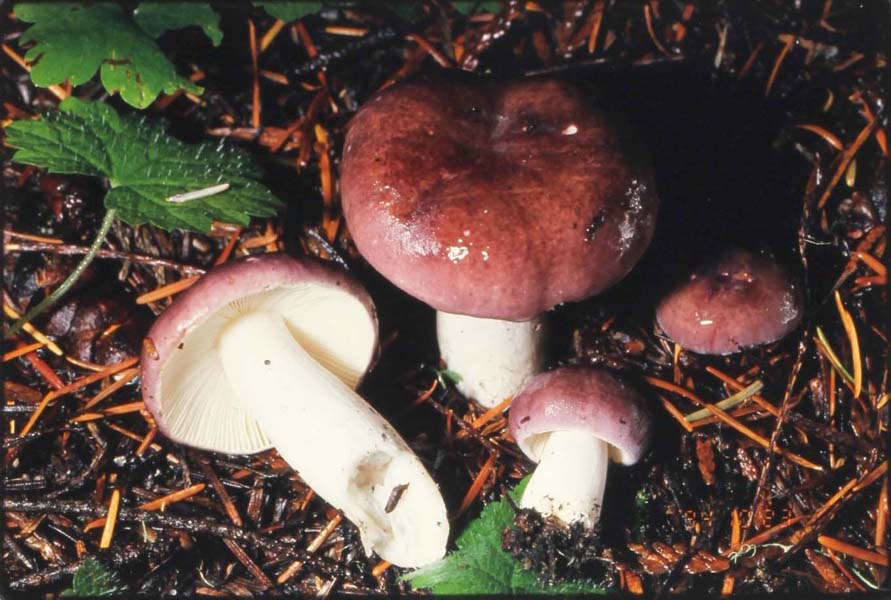

Russula ‘murrillii Woo 70’
© Ben Woo, encrustations on the pileal primordial hyphae © Danny Miller
Yellow Russulas – encrusted hyphae or not
Russula 'postiana Woo 69'
-
This rare, often bright yellow Russula has been going by the
name R. lutea (synonym R. risigallina) over here for many years. It’s not always yellow, and specimens with other
colours have been called R. chamaeleontina, for its chameleon-like
properties, but that species is now assumed to be the same as R. lutea.
Although our species DNA is twice as close to R. postiana as it is to
R. lutea, the one collection with spore measurements better matched R.
lutea. Hmm.
Although in Europe the true
R. postiana can have olive or brown tones (and maybe even a hint of pink or lilac), the
only documented case of our species in the PNW is being bright yellow in Seattle
under Madrone, although it’s famous for its spruce habitat in Europe. Like the
R. turci group, R. postiana is in the clade with encrusted primordial hyphae,
but not to the same extent, because although you can find them under a
microscope, they do not seem to be sufficient in this species to make the cap matte or pruinose; it’s still relatively shiny. The spores are especially dark
yellow, almost orange, possibly the darkest colour of any of our Russulas.
This is another case of there being two similar European Russulas, in this case
R. lutea (risigallina) and R. postiana, with mycologists deciding that our
bright yellow Russula was probably R. lutea, but DNA evidence showing it
is closer to R. postiana. (A similar thing happened as
described on previous pages with R. pallescens vs. R. farinipes, with
R. vinososordida vs.
R. decolorans, with R. cerolens vs. Russula sororia and pectinata and also with
R. sapinea vs R. puellaris). Ours may not be the same species, though. Ben's
sequences of ITS2 showed 1-3 differences, not necessarily enough to justify a
new species, but more recent sequences of ITS1 have shown that there are an
additional 3-4 differences in ITS1.
Russula chlorineolens OR -
this is a trufflized sister species, with a strong chlorine odor and
distorted gills that can turn deep yellow/ochre. The cap is cream
colour and not nearly as yellow as its epigeous relatives. It is from spruce
and hemlock.

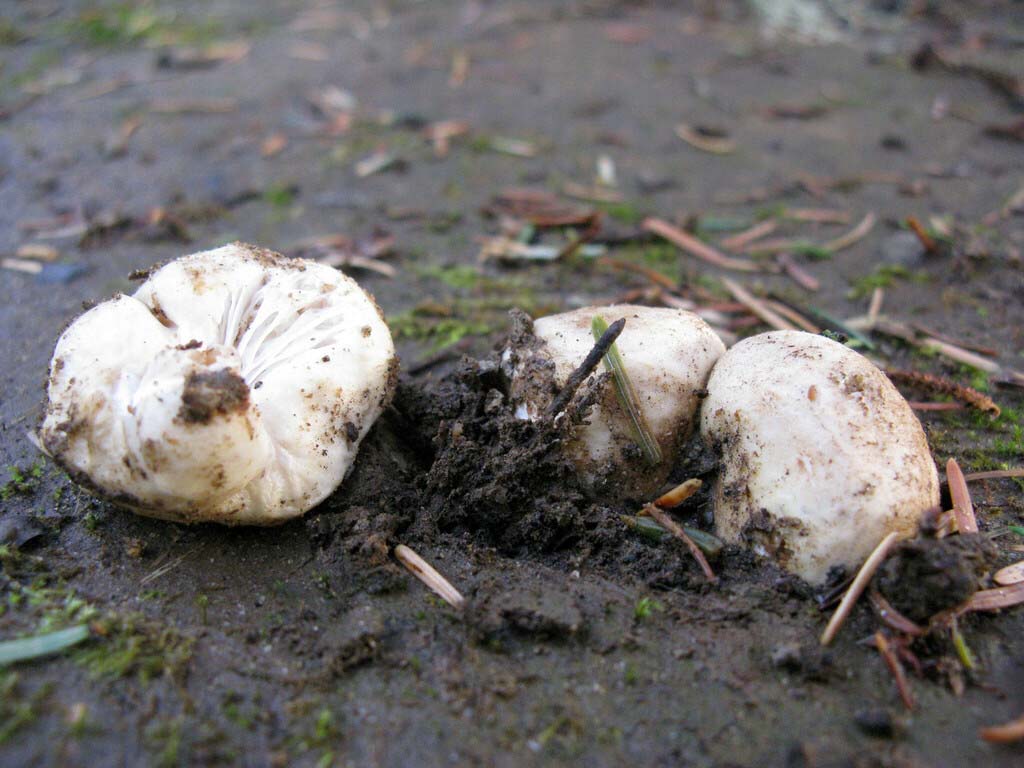
Russula 'postiana Woo 69'
© Ben Woo, R. chlorineolens © Michael Beug
Russula 'olivobrunnea Woo 46'
-
This rare slender lookalike of R. postiana can also be bright yellow,
but it is not closely related to any of our other local Russulas and does not have the encrusted pileal hyphae.
The spores are dark yellow, but not
quite as dark as R. aff postiana, and a little larger. It is
said to grow with spruce and fir, instead of hardwoods, but the three times it was found in the
Blue Mountains of Eastern Washington and Idaho, the trees were not noted
(although they are largely conifer forests). Recently, it was just collected
near Bellingham under Doug fir and alder so it is on the west side as well which gave us an ITS1 sequence.
There are a total of 6 bp differences in ITS from R.
olivobrunnea EU, pretty clearly enough to make this a separate species in need
of its own name. R. olivobrunnea is also quite differently coloured, often dark
brown with an even darker centre. Russula olivina EU is also a
close relative, a yellowish species
with olive or brown tones.
Russula Woo46a - a close
relative to the yellow Woo46, but like R. olivobrunnea, it is
purple coloured and illustrated in the zelleri group section.
Russula PNW16 - another relative of R. olivobrunnea, but also
purple and illustrated in the zelleri group section.
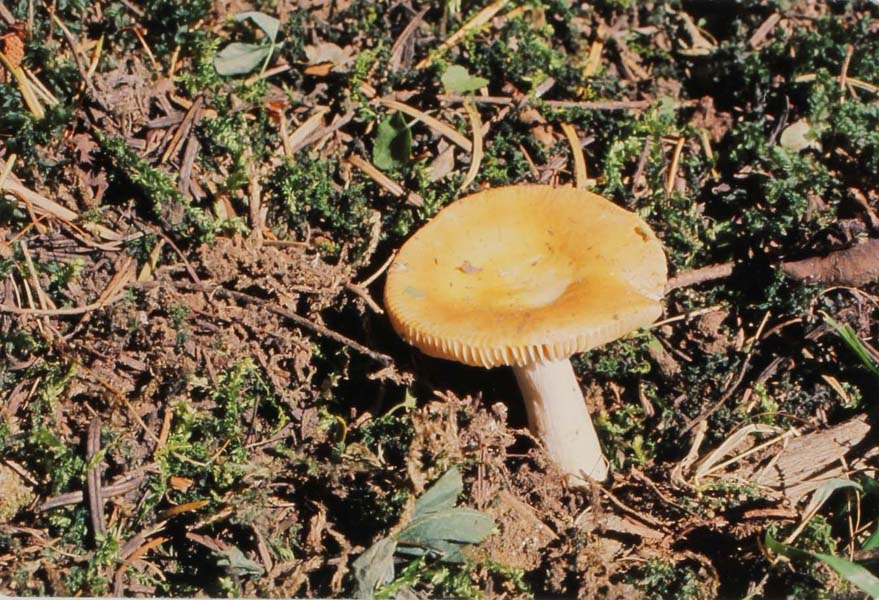
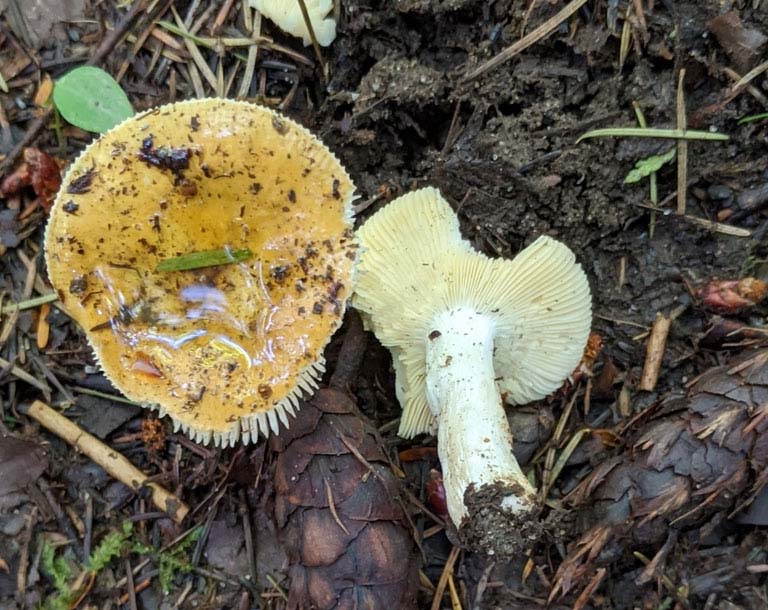
Russula 'olivobrunnea Woo 46' © Ben Woo and Sharon Squazzo
Russula sp. Woo 65 -
This sometimes yellow species also doesn't have encrusted cap hyphae and
is probably most easily mistaken for Woo46, but is is a stockier
mushroom with paler yellow spores. It was only found by Ben twice, once in Idaho and once near Glacier Peak,
WA (near Doug fir and hemlock). In the two collections the cap colours were yellow
(flesh did not stain) for the ID collection, and dirty brown (flesh stained
orange then grey),
for the WA collection. But there may have been a mixup and only one of those may
represent this species. This species is in a group with Russula
sierrensis and R. integra. Subsequently it has been found on
Vancouver Island and Arizona (all with conifers, varying from sea level
to high elevation) and we have a full ITS sequence, and it whitish
or yellow, and the flesh does not seem to appreciably stain, so the dark
brown collection that had flesh that stained orange then grey may have been a
mixup. I don't know what it was.


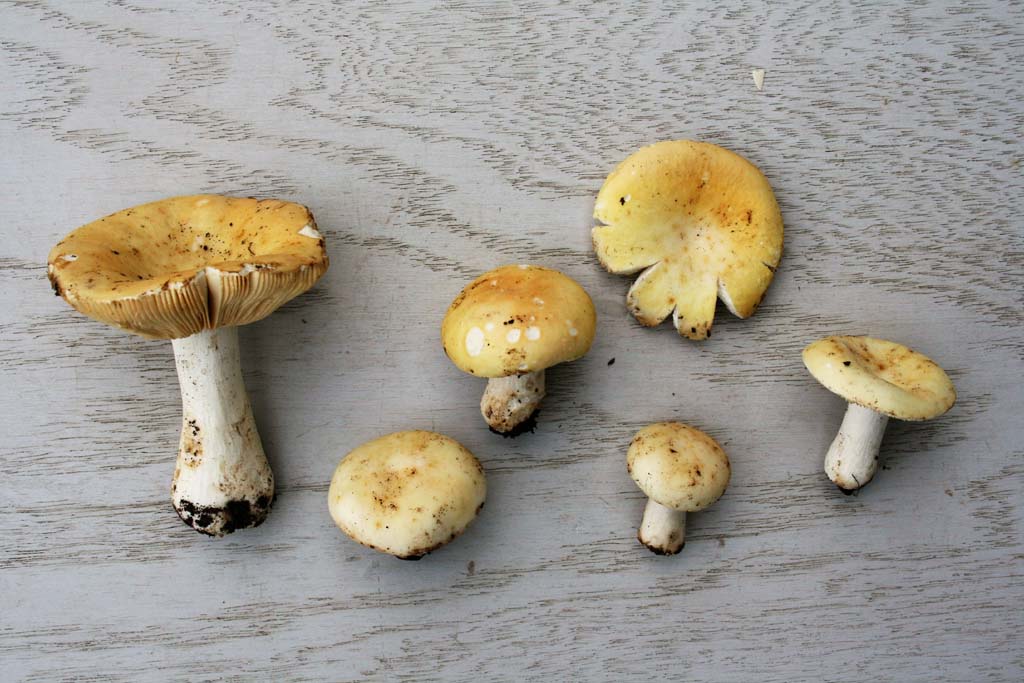
Russula Woo65
(incorrect, mix-up?) © Ben Woo, R. Woo65 © Marty Kranabetter (2 images)
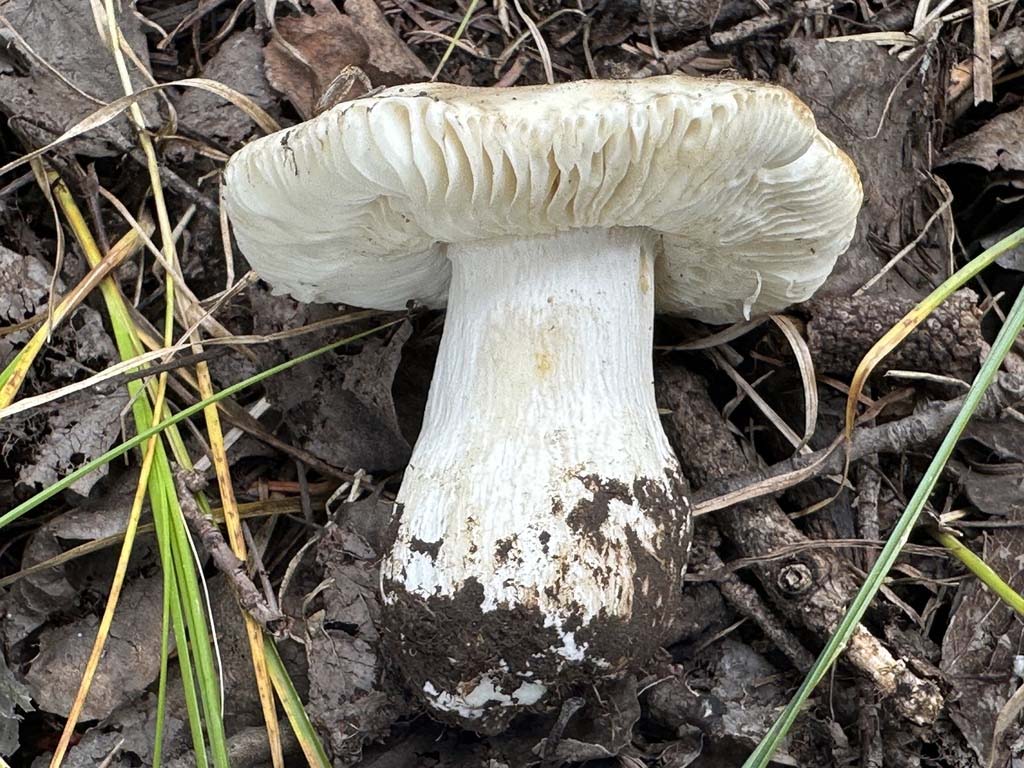
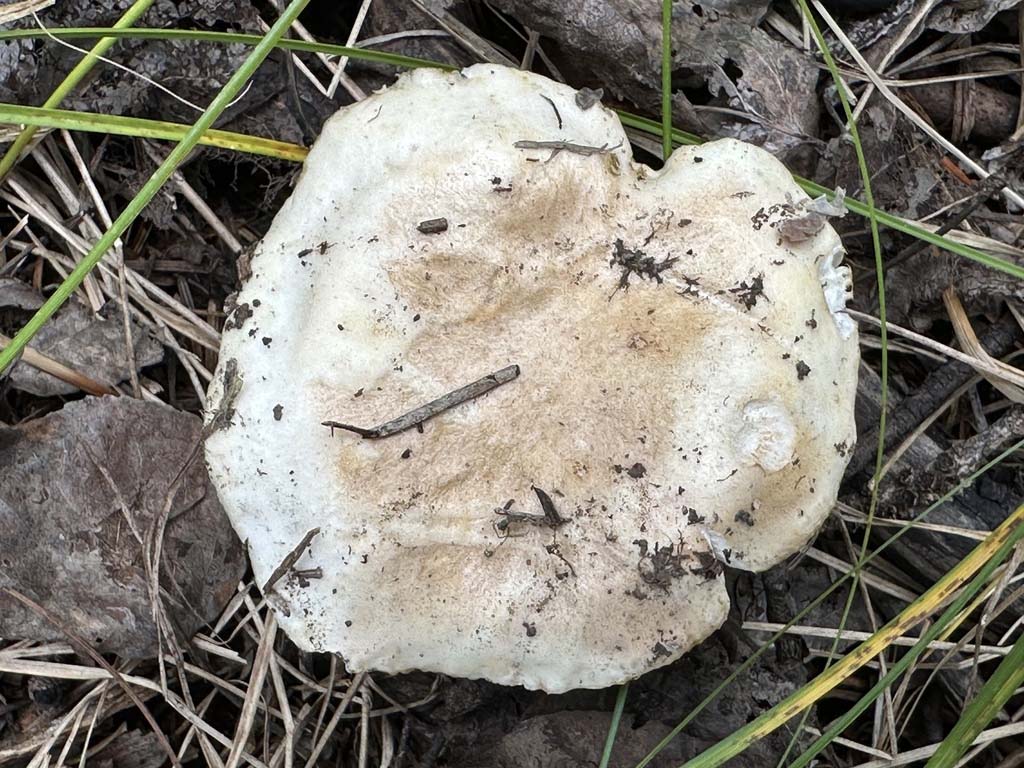
Russula Woo65 (from AZ)
© Jonathan Frank (2 images)
Russula 'basifurcata PNW01' - this white oak Russula has a
cap tinged with yellow or reddish-yellow, and a pale yellow spore
print. This meets the description of R. basifurcata, but as that is a
poorly understood species, I'm giving it a code for now. It has been
sequenced twice, once under oak in WA and once in CA. Ben never found it.

Russula 'basifurcata PNW01'
© Michael Beug
Russula 'intermedia PNW02'
-
This is a very pale yellow capped Russula (almost
white), with very dark ocher spores notable by the fact that the gills are much brighter than
the cap.
It is rare, only found once so far near Mt. Rainier (and a
memory that I might have seen one 10 years ago near Leavenworth). The nearby
trees were not noted, but the closely related R. intermedia is a birch
species with a bright red cap that might fade to yellow in the centre. Our
species is 8bp and 1 indel different in ITS.
Russula 'ocher oaks PNW03'
- a very similar almost white cap and very dark ocher spores, but this
species is with oak and is found in a different part of the genetic tree.
One collection showed pink around the rims. Rumour has it that California has 2 similar oak
species, this is probably one of them. We have one sequence from OR and one from
CA.

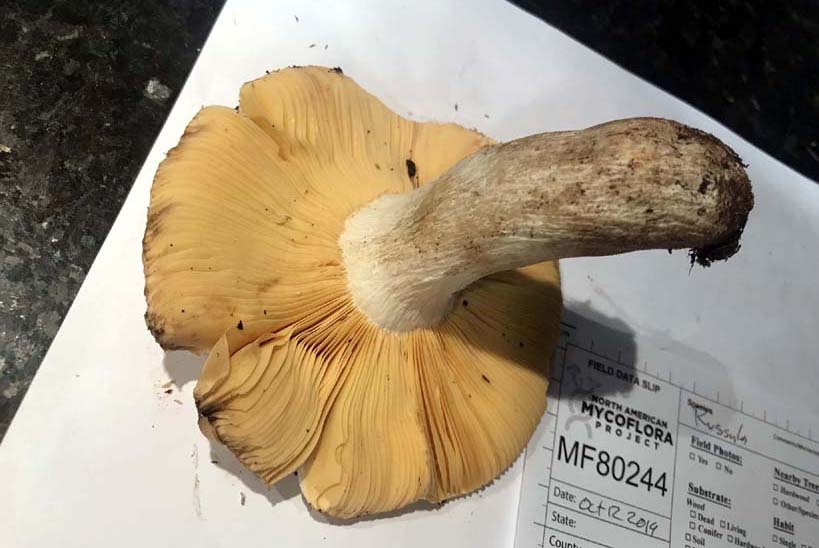
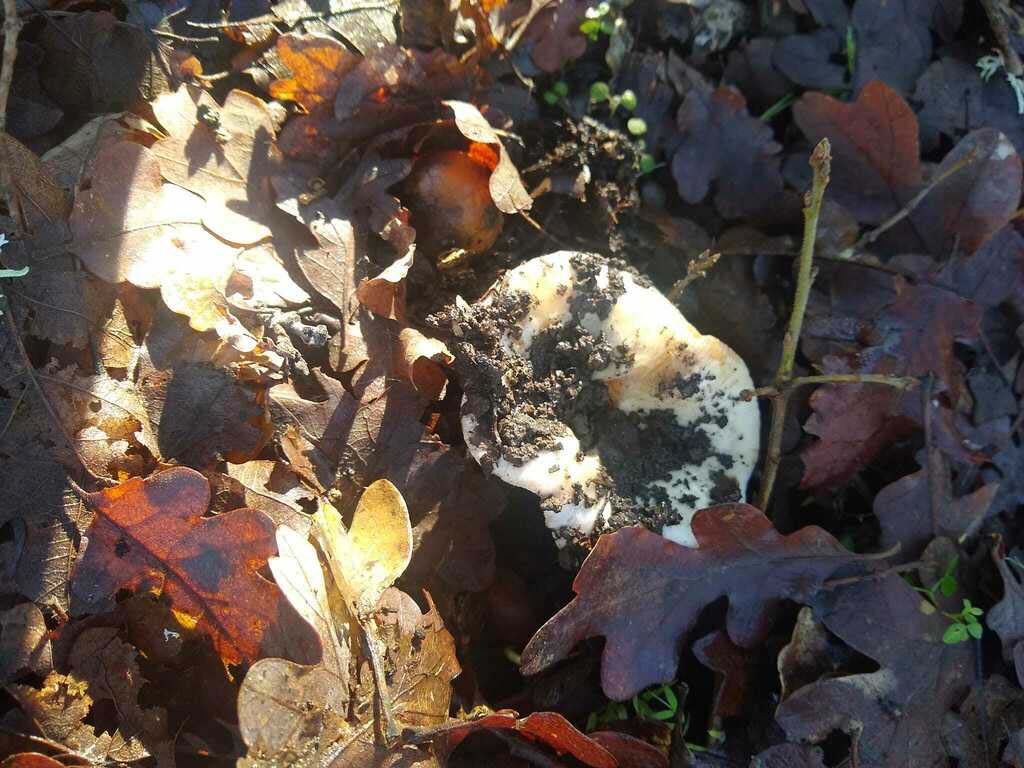
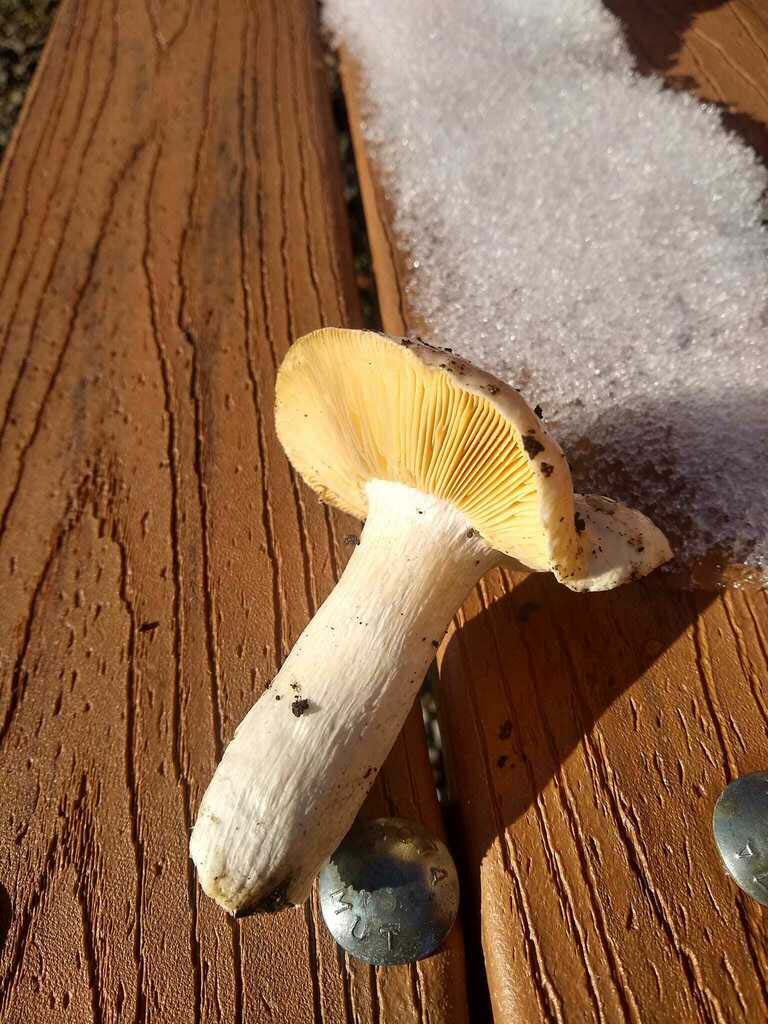
Russula 'intermedia PNW02' © Danny Miller (2 images),
R. 'ocher oaks PNW03' © Valerie Engle (2 images)
|
 Russula zelleri group - click to expand Russula zelleri group - click to expand
This is a group of at least 5 related species, very hard
to tell apart, and one similar species outside the group. For the most part, they are somewhat fragile, mild tasting,
purple (sometimes with red), yellow spored Russulas with normal shiny caps.
Five of them definitely match that description; two other mystery Russulas are
somewhat related but look different. They are much like the R. turci group
except they don’t have the encrusted pileal primordial cystidia, so they do not
have a matte or pruinose textured cap.
Species mentioned: Russula cessans, lilacea, zelleri, obscurozelleri, pseudotsugarum
The first 5 species have been going under the name
R. cessans, a European Russula that may or may not be in this group
(another possibility is the yellowing clade), but that does not actually occur
here. Nobody had studied our R. 'cessans' closely before the study of Ben’s
collections to notice that there are really multiple species, and even if they
had, they are very difficult to tell apart from each other. Russula zelleri was
described, you guessed it, by Burlingham in 1936 from Oregon, in the same
publication where she described R. mordax, and similarly, not much attention was
paid to it, but if it had been, we might have noticed long ago that what we have
long called R. cessans over here was actually R. zelleri and other related
species.
Here is an interesting story about a mushroom that does not
occur in the PNW, R. lilacea, and how the very different R. zelleri group
members were mistaken for it. In 1965, Darryl Grund’s UW PhD dissertation stated
that the mild, dark yellow spored, purple European Russula lilacea was
found very commonly in the PNW. He failed to notice that the description of R. lilacea was of a white spored mushroom, and he mistakenly stated that it was a
yellow spored mushroom. He was actually finding members of the R. zelleri group.
When Ben Woo made his Russula key in 1989, he followed Grund and stated that R. lilacea was very common in the PNW, but he did not copy Grund’s description of
it, he went back to the original texts and wrote down the actual description of
R. lilacea, not noticing the discrepency. So Ben’s key states that the mild
tasting, white spored purple Russula lilacea is very common here. Then,
many people happened to find a mild tasting R. phoenicea, a white spored Core
clade member, and mistook that species for R. lilacea, not looking at the
microscopy.
Russula zelleri OR -
Russula zelleri itself is the third most common species in the
group, occurring with spruce and pine. While usually purple, it has
been noted to come in red or green colours too. There is a single ITS1
difference between recent collections and the 1936 Oregon type, and among the
collections there may be 1 or 2 ITS2 differences.
Russula subloculata ID -
This may be one of those common cases where the secotioid mushroom evolves so
quickly, ITS doesn't change. You cannot tell this apart from R. zelleri
by ITS, so that is the species that is trufflizing.


%20WA%20iNat143444388.jpg)
Russula zelleri
© Ben Woo (2 images), Russula subloculata © Andrew
Parker
Russula pseudotsugarum WA -
The second most abundant species in the group, it can be found
with spruce and pine as well, but also Doug fir and hemlock. It was recently
named by Anna for its ability to associate with Doug fir (Pseudotsuga). It can
also occasionally come in red or other colours like brown and green, making it
very hard to recognize. It is almost identical to the
next species. One collection had a very, very grey stipe, but that may have just
been unusual waterlogging.
 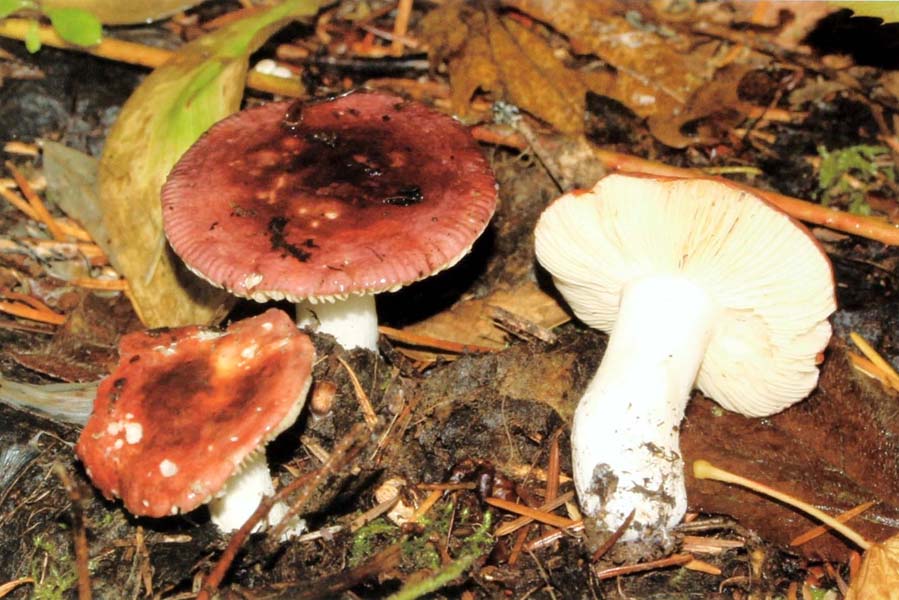
Russula pseudotsugarum
© Ben Woo
Russula obscurozelleri WA -
The most abundant species in the group, almost identical to
R. pseudotsugarum and found near the same trees. It is named for its difficulty to
tell apart from the other zelleri members. It can also
fade to brownish yellow colours. One Washington collection tasted acrid, which
confuses me.
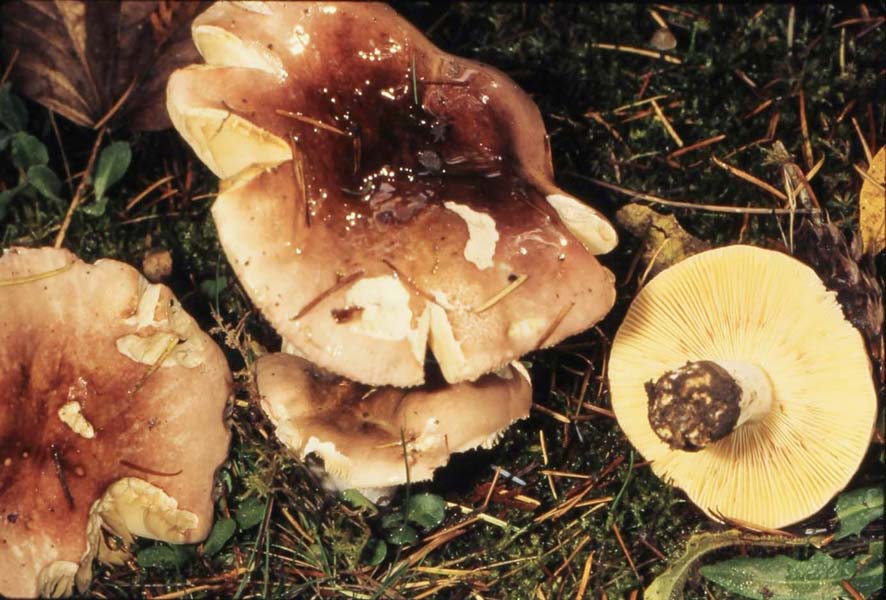
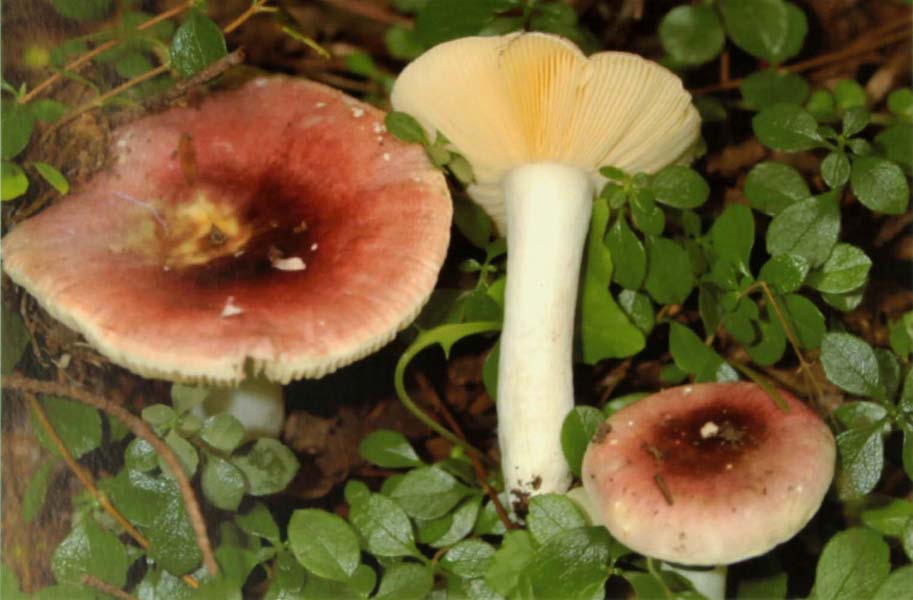
Russula obscurozelleri
© Ben Woo
Rare relatives of R. zelleri
Russula sp. Woo 51 -
This rare species is very similar, purple or purple-red,
found only twice with spruce and pine on the Oregon Coast. We only have
ITS2 of this species. There’s no way
yet to tell it apart from R. zelleri. There is a hypogeous species in
California, CA17, with one collection having the same ITS2 as Woo51.
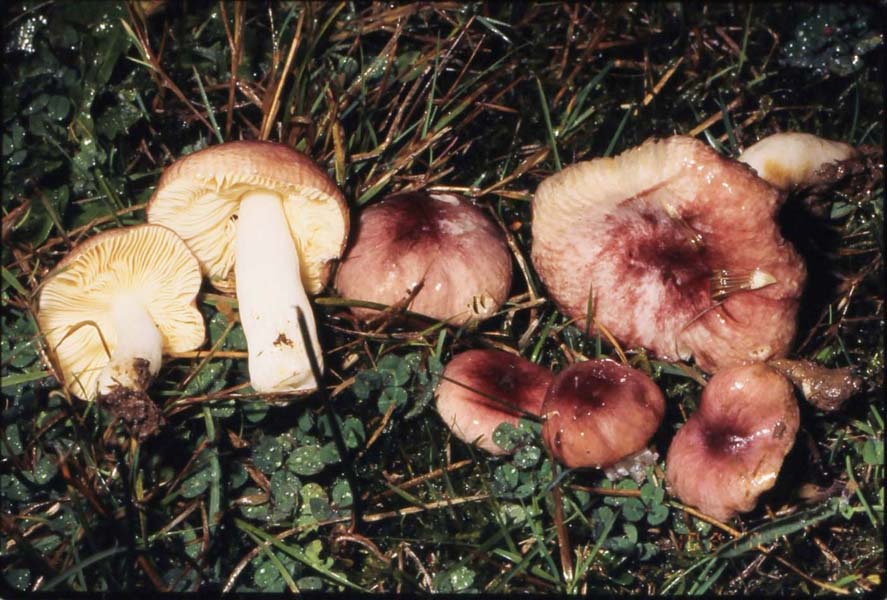

Russula sp. Woo 51
© Ben Woo
Russula sp. Woo 51a -
from a coastal Victoria BC Douglas fir forest and from a CA pine forest. It has
a quite deep purple cap.

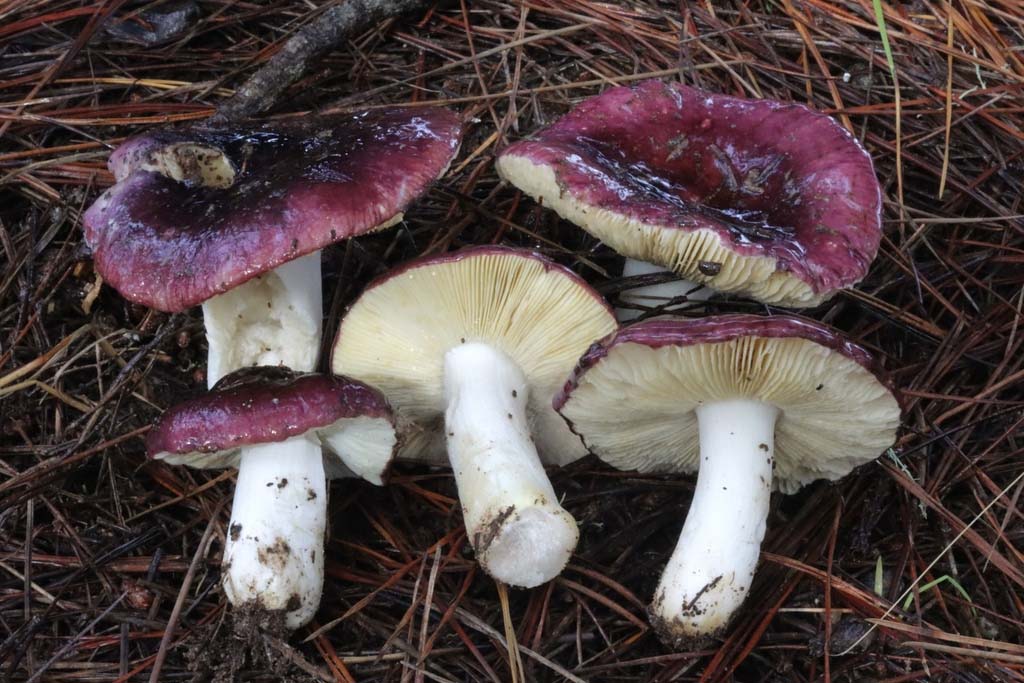
Russula Woo51a © Marty Kranabetter, R. Woo51a © Taye
Bright (from CA)
Russula sp. Woo 52a -
two sequences from WA (different by 3-4 bp from each other) and one from Smithers, BC
that matches one of the WA sequences. Our one good photo shows faded
purple.
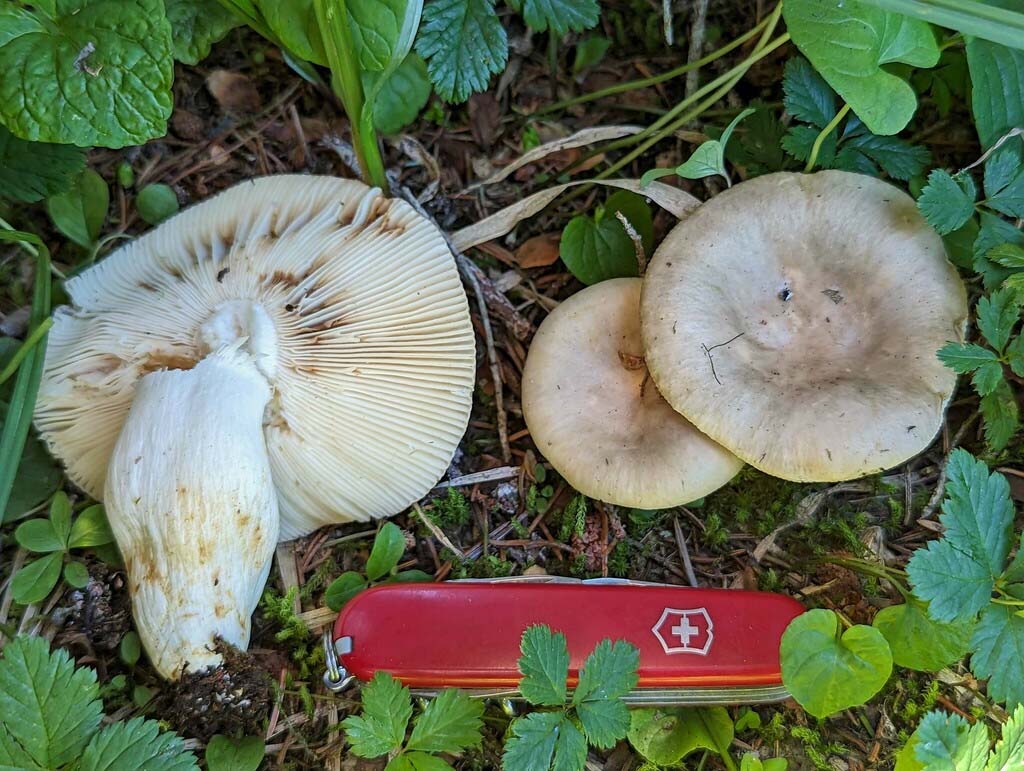
Russula Woo52a © Michael Beug
Russula Woo46a - a close
relative of the yellow Woo46, illustrated in the yellow Russula
section, but like another close relative, R. olivobrunnea, it is
purple coloured and therefore resembles all of the mushrooms in this
section, although it is not closely related to them. This is currently very
difficult to ID. It is known from a single Victoria BC collection. I wonder if
it has very dark yellow spores like R. olivobrunnea.
Russula PNW16 - a similar
purple capped close relative of R. olivobrunnea, which does appear
to have dark yellow spores like that does, but it's unclear how much
darker than the other R. zelleri relatives in this section those spores
are, and if that can help identify it. We have one collection from ID and one
from OR.
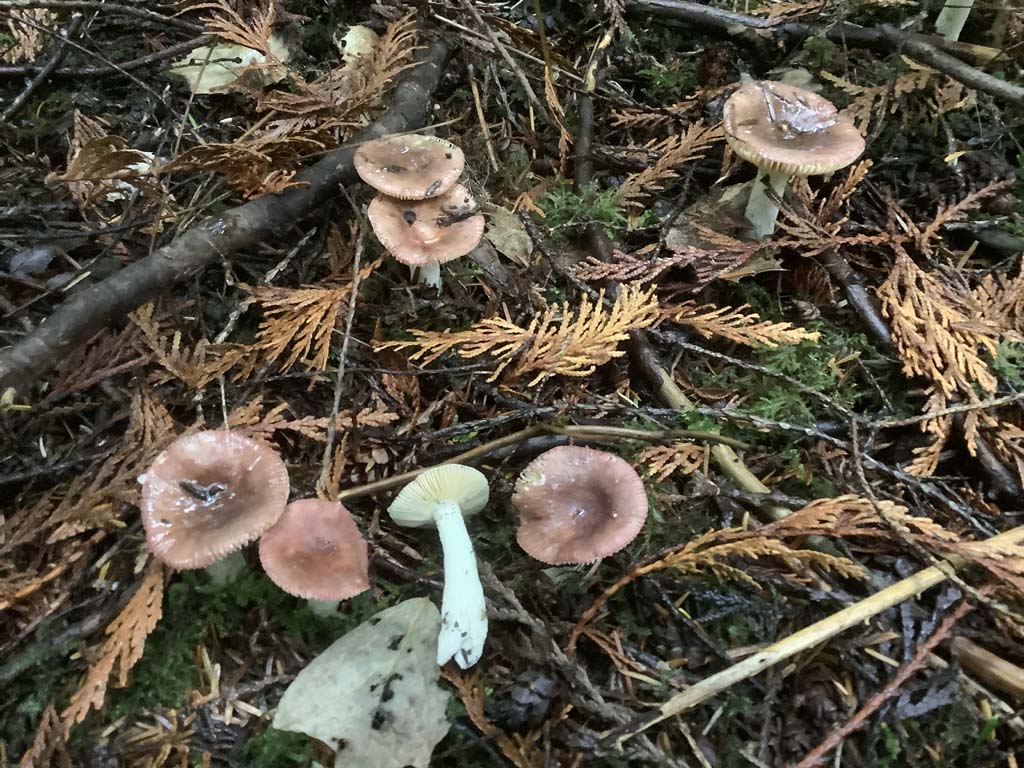

Russula Woo46a © Marty Kranabetter, Russula PNW16 ©
Ed Barge
|
 Other Russulas - click to expand Other Russulas - click to expand
Species mentioned: Russula graminea, urens, cuprea, nitida,
sierrensis, velenovskyi, benwooi, placita, murina, inconstans, maxima,
persobria, citrina forma separata
Russula graminea EU -
This European Russula
is fairly closely related to the R. zelleri
group, described on the "zelleri group" page. It is green or greenish-yellow, so it could be
mistaken for R. aeruginea and possibly others. Four Alaskan collections,
however, only have some green, usually on the disc, with the rest of the cap
being purple (the most common colour of other R. zelleri group
members). It was not known from the PNW
until Anna’s study of Ben’s collections.
Our DNA is basically an exact match to
R. graminea in Europe, with the exception of some confusion about how long a
string of identical letters might be in a couple of places. This likely
represents not being able to reliably tell the length of the string, not actual
differences. Everybody probably mistook it for R. aeruginea and never looked at
it too closely, but it is just as common (or not uncommon) as R. aeruginea is.
It is known as a spruce species in Europe, but here it can also be found with
our common conifers like Doug fir and hemlock. In Alaska, it was always found in
a spruce-hemlock forest. The hot tasting yellow-green
European Russula urens/cuprea that has been reported as being commonly
found here has no evidence of actually existing in the PNW. R. graminea was
once recorded as hot tasting, so this is probably the basis of those
reports. If you find a hot green Russula with dark yellow spores, save it so we
can double check.
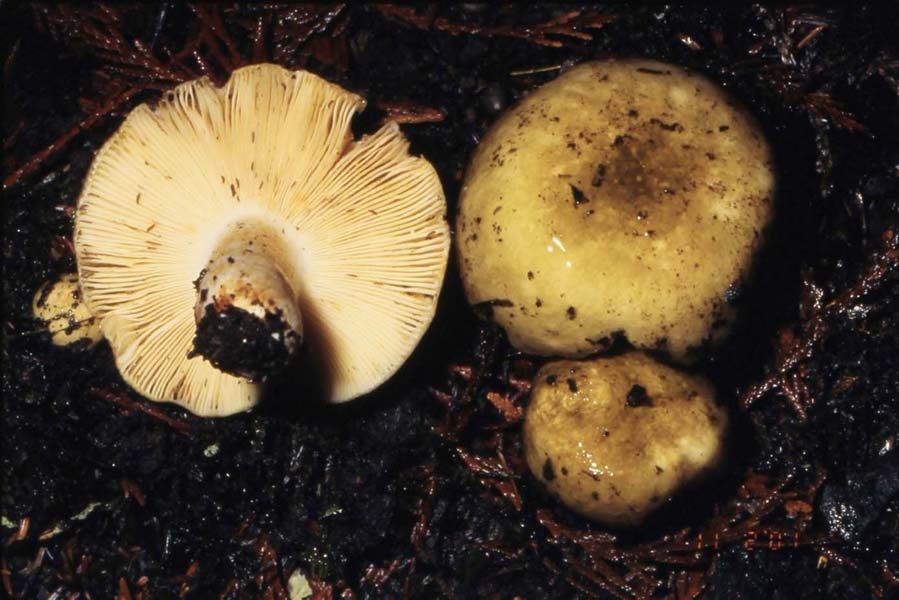
Russula graminea
© Ben Woo
Russula sp. Woo 48 -
These next two species are also somewhat related to R. zelleri,
but not closely enough to look like it nor necessarily share many of its
properties. R. sp. Woo 48 is rare, found once in Shelton near Olympia, WA near
unspecified conifers. It had some purple in the center but the rest was pale to
medium brown or had faded to brown. We don’t know what its usual colour scheme
would be and if it can mimic the other purple species or not. For now, I can't
say anything about how to recognize it.
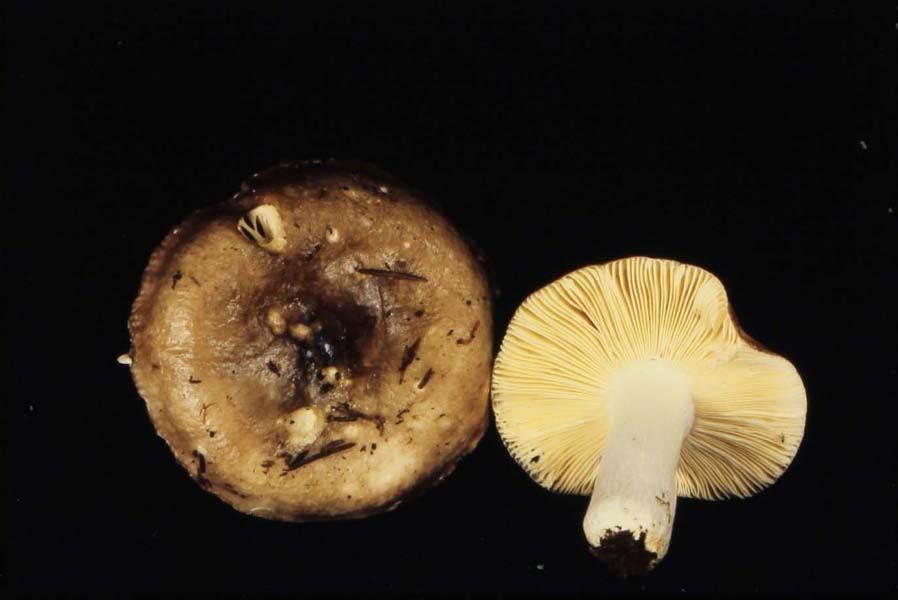
Russula sp. Woo 48
© Ben Woo
Russula sp. Woo 49 -
A rare sister species to sp. Woo 48, it was found once near Satus Pass in S. Central WA near pine and Garry
oak, it was entirely cream coloured with little pigment. Also found near Santa
Cruz, CA, where it was reported as red and yellow, and near Sly Park CA. It is not known
what its usual colour scheme is. Very little is known yet about how to
recognize either of these species.
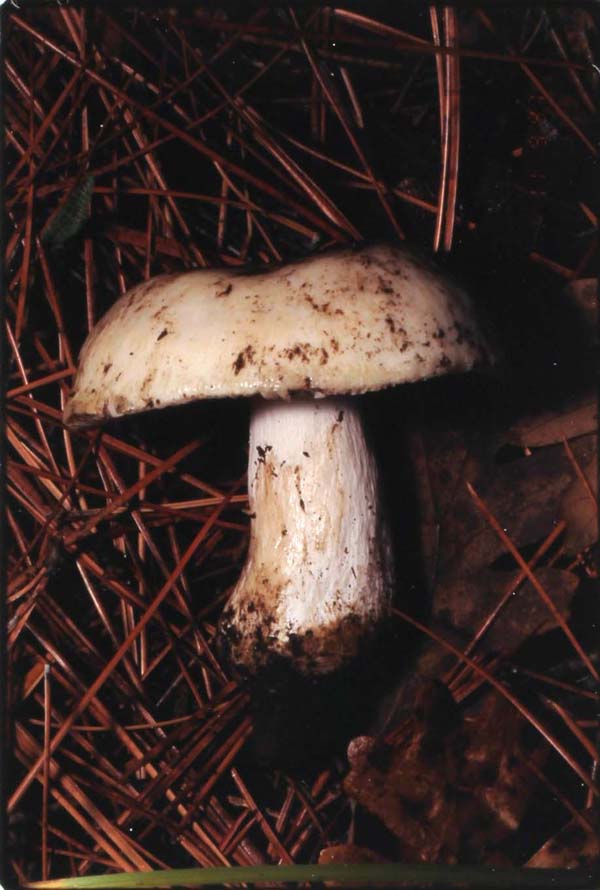
Russula sp. Woo 49
© Ben Woo
Russula nitida -
This is a European birch species with a wine-brown cap and a stem
flushed with red/purple. Our
single collection had neither of those properties, but it was found in a Seattle
park with birch as one of the many types of nearby trees. Little is known about
how to recognize it over here.
Russula sierrensis CA (=Russula
pacifica CA) -
Both type sequences match and are from the same publication, so no name has
priority, but I've been using the name R. sierrensis, as that was
sequenced first, so I will continue to do so. It is fairly common at times. It can be
found all over the PNW (from the Idaho interior to the Washington
Cascades to the Oregon coast) under conifers (either Doug Fir or spruce
seem to always be present, although in California it’s reported with oak and
pine). The reason we never noticed it north of the California border before is
that this study showed it doesn’t often look like it did when it was first
found, it’s a much more variable-looking species than ever thought, so it
was never recognized. Unfortunately, I have no good means of identifying it yet,
but this species should be studied in more detail since it is not uncommon (Ben
found it 14 times). It’s supposed to be a mild tasting purple-red Russula
with a pale yellow spore print, but the spore print can often be dark yellow and
the colour can be almost anything. Oh look upon the many faces of Russula
sierrensis and despair. It’s possible one of these specimens could have gotten
mixed up and not be this mushroom, but not all of them. Any Russula not
confidently identified as something else (and that might be most of them) should
be microscopically examined carefully for a match to this species, with separate
spore warts that rarely connect and pileocystidia (special cells in
the cap cuticle not always present in other species). It would be really helpful
to get a reliable description of this species.
The type of Russula pacifica seemed to stain grey, and this species is
close to Woo65, which in one collection stained grey, although R.
sierrensis was never reported to stain grey. This is somewhat mysterious.
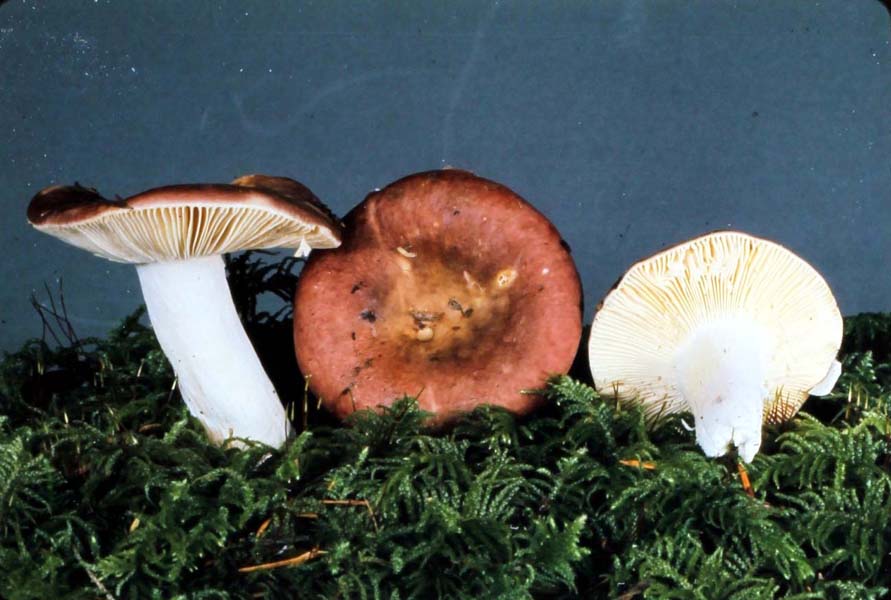
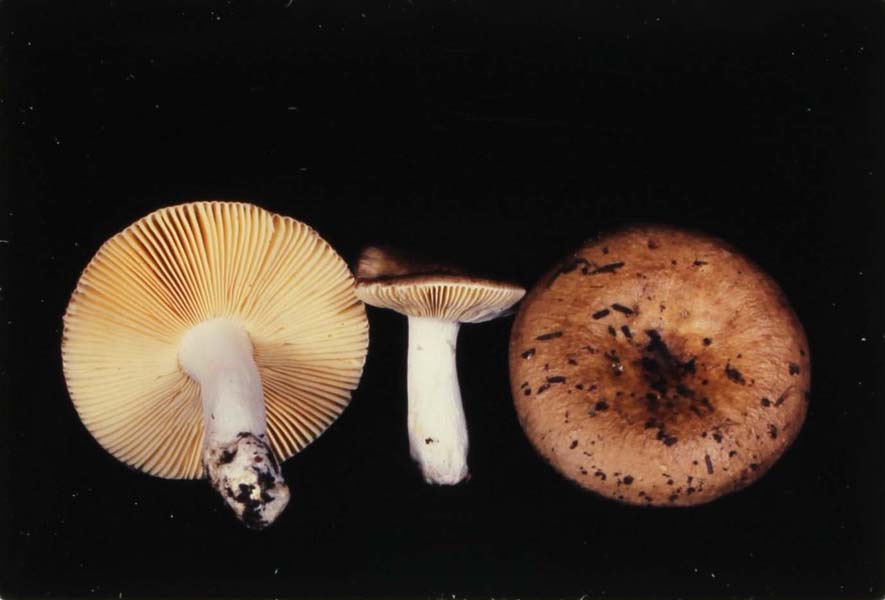
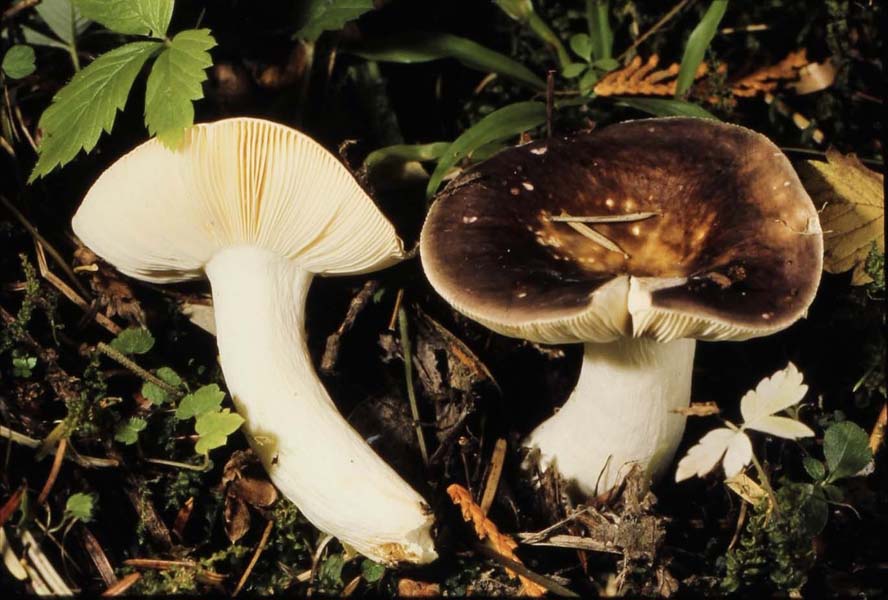
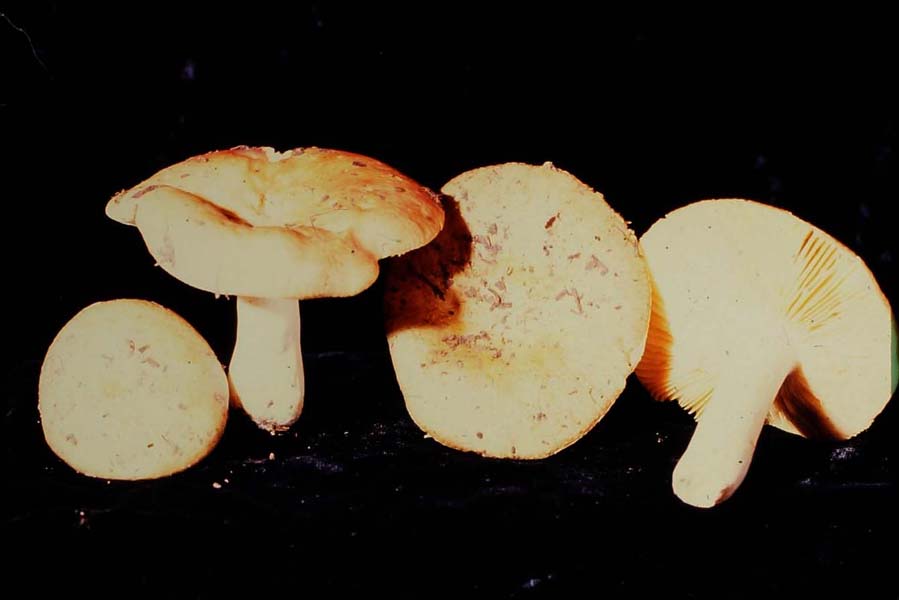
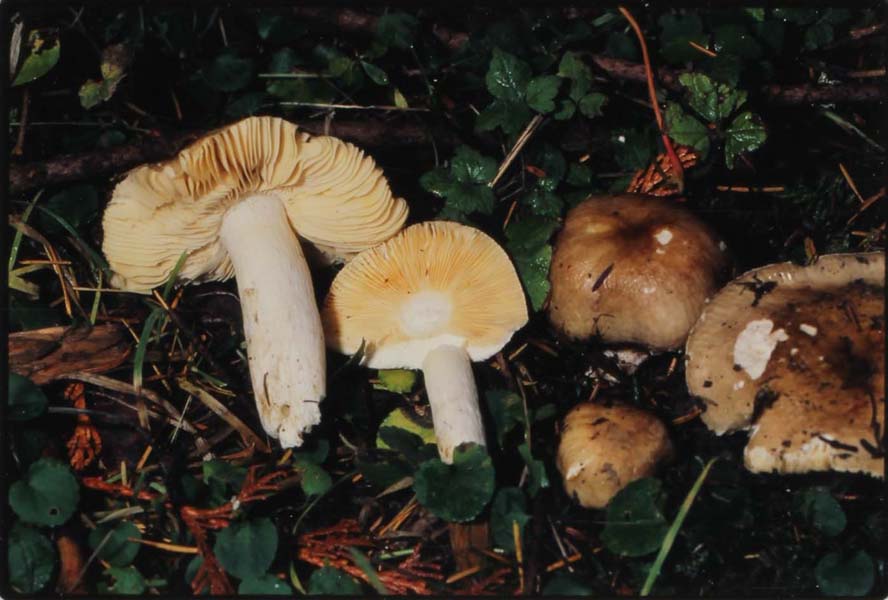

The many faces of Russula sierrensis
© Ben Woo
Russula 'velenovskyi Woo 64'
-
This rare mushroom, related to R. sierrensis and others in the
R. vinosa group, does not stain and was only found once under an introduced
birch tree in Seattle. It is about 5 bp different in ITS2 (~0.7%) than the
European species and may represent a unique species. In Europe, it has been
found with other kinds of trees as well including conifers. It has a
peachy-orange cap and creamy yellow spores that are not as dark as
most of the others. It kind of resembles R. vinososordida but does not stain.
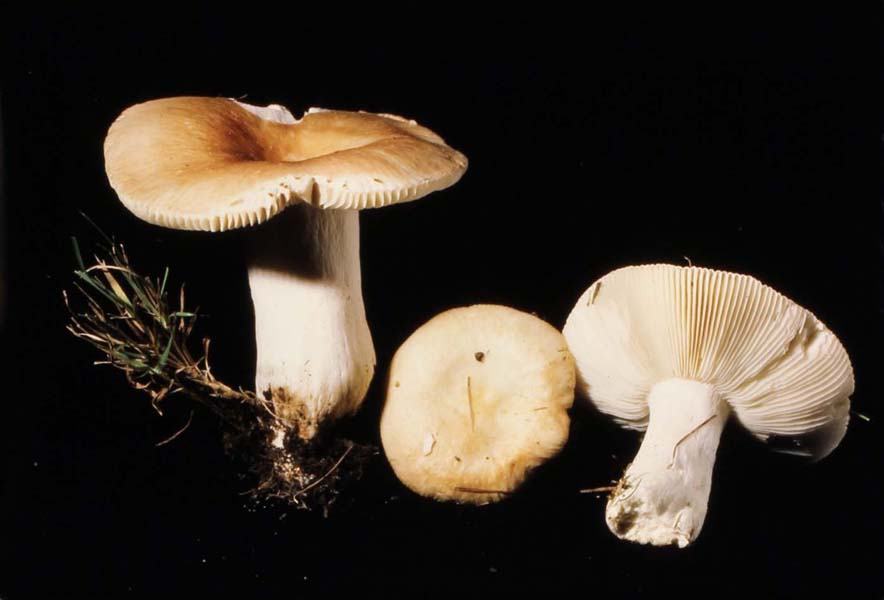
R. 'velenovski Woo 64'
© Ben Woo
Russula benwooi WA -
I have saved one of my favourites for last. Normally, when we discover a new
species in the PNW, all we are really doing is admitting that our species isn’t
really the same as the European mushroom whose name we’ve been using for it, but
that enough differences were found to justify separating it out and giving it a
different name. That’s not the case here. Arguably the most interesting result
to come out of Ben’s study was that one very abundant Russula, found at least 60 times (second only to how often
R. mordax was found)
was something completely different than expected. This Russula was large, and
kind of looked like our R. 'xerampelina' and R. vinosa, and was always mistaken for
one of those two. Did it smell like shrimp or turn green in FeSO4? No, and
anybody spending just a few seconds to try those things during the hundreds of
times it has been collected would have noticed it was not a shrimp Russula
like
they thought. But when you’re finding them by the hundreds, who has time to test
every one? You just start assuming you’re looking at yet another one. Anybody
who thought it was R. vinosa could have dispelled that myth quickly by
scratching it and noting that it did not change colour, but sometimes it has a
faint grey tinge to the stem and if you don’t look too closely, you could
imagine it was probably a greying reaction happening, and not bother to spend
any more time on it.
Thus this Russula, not closely related to any known Russula that
was ever rumoured to exist in the PNW, went unnoticed for decades. I’m just as
guilty as everyone else for not looking closely at it but dismissing it as one
of the two other unrelated species. It may be closely related and is similar to
R. paludosa from Europe, but nobody ever suspected that mushroom might be here.
As soon as I heard of this cool discovery from Anna’s study of Ben’s collection,
I advocated for naming it after him, which finally happened in late 2017.
It is
a large Russula, easily reaching 10cm. This fact alone might help make it
possible to identify (as opposed to the similarly chameleon-like but
normal-sized R. sierrensis. The cap colours can be
quite variable, but are often brownish-tan, perhaps with areas of
olive and
darker spots of red or purple (or sometimes entirely olive or red or
purple). The stem may flushed with a hint of purple (like our R. 'xerampelina')
perhaps with a faint greyish tint (as if it is
greying like R. vinosa), both also large species, which it has traditionally
been mistaken for. In one Alaskan collection, the purple flush on the stem was
significant. In one collection, it had yellow rhizomorphs!
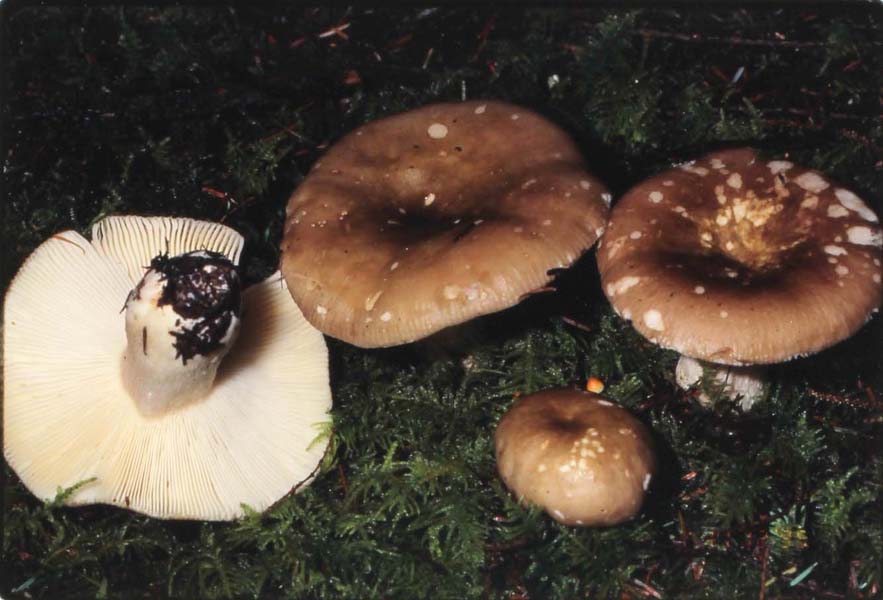
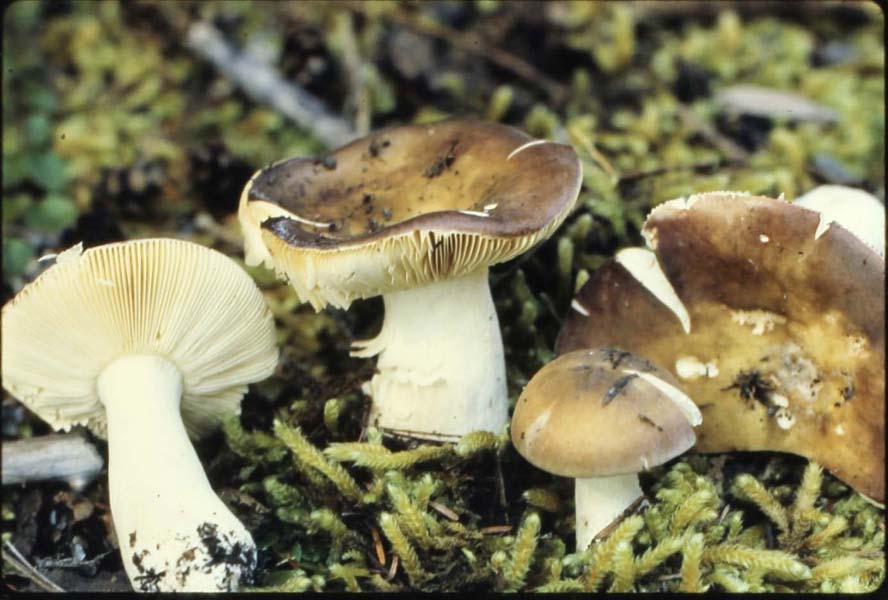
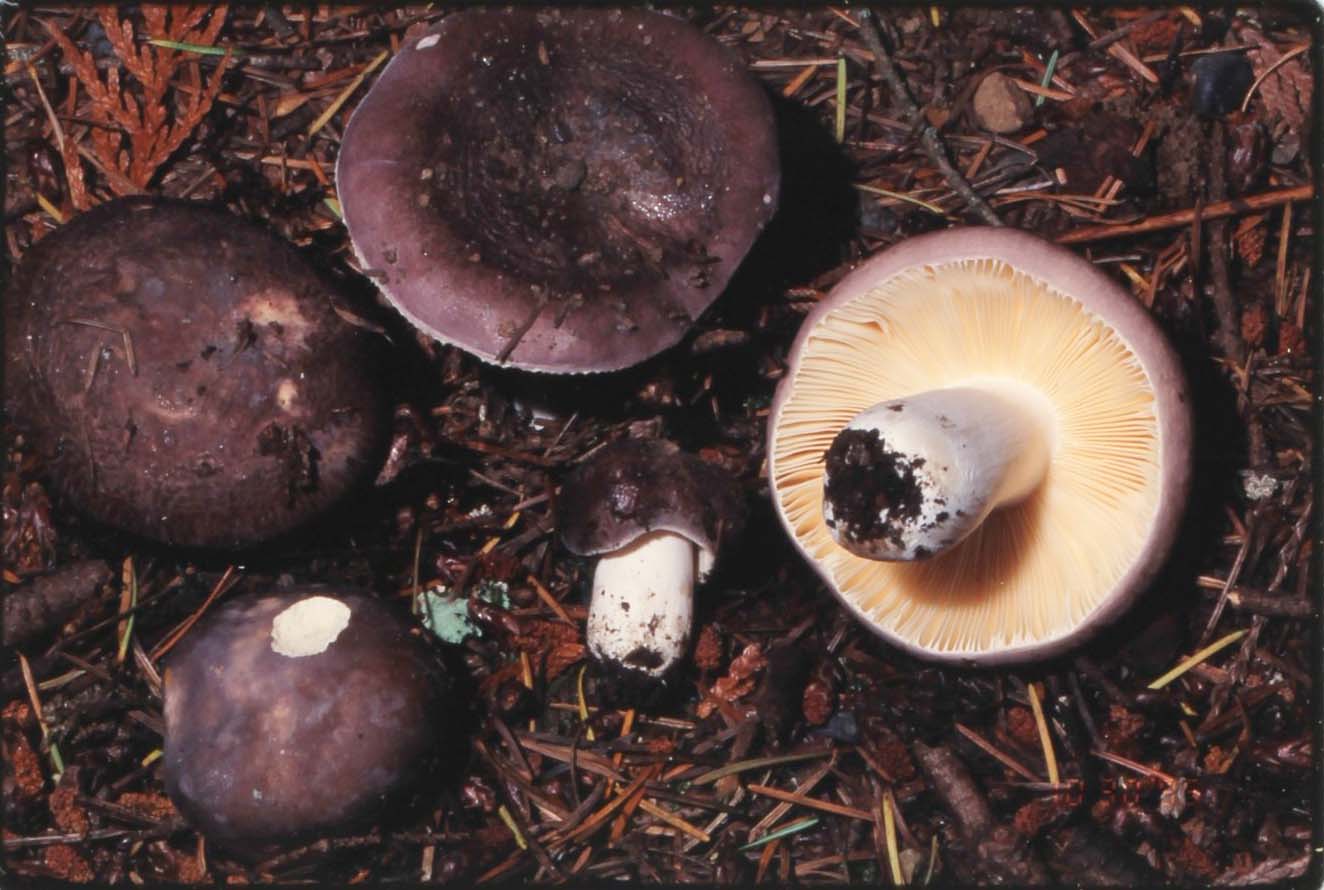

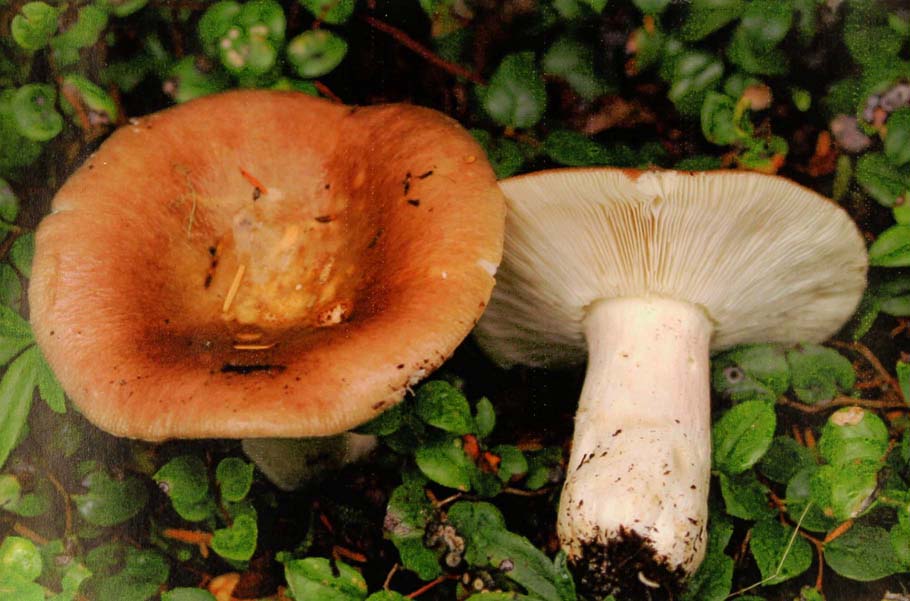
Russula benwooi
© Ben Woo

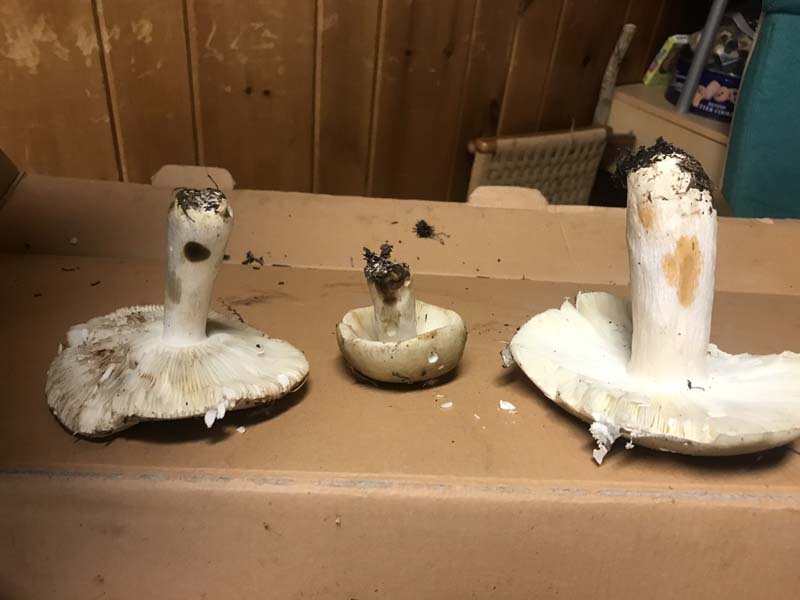
R. viridofusca (in the xerampelina group of shrimp Russulas)
on the left, with the stem turning green in FeSO4.
R. vinosa in the middle, with the stem turning grey where
scratched.
R. benwooi on the right, with the stem not changing colour
when scratched and turning the ordinary rust colour of iron in FeSO4 instead of
green.
Photos
© Danny Miller
Unsolved Russula mysteries
If you are thinking that we should pay close attention to other
Russula species described by Burlingham in 1936, you’re right. There are
others, whose identities are not yet understood, as well as a few Russulas
described by others that are not yet understood.
R. placita WA - (a hot purple
Russula)
R. murina OR - (slowly slightly hot olive-grey Russula)
R.
inconstans FL - (slowly slightly hot Russula with a red margin and
yellow-brown center)
R. maxima WA - (a large, mild, purple Russula with a
rose coloured stem) described by her in 1915.
R. persobria OR - (no idea what it is except the cap appears to be green in
the dried type collection) described from Oregon in 1939.
R. citrina f. separata WA - (a hot white spored yellow capped Russula
in clade Russula core). The European Russula citrina is now
thought to be a synonym of the European Russula ochroleuca. We likely
don't have that species here, so this form described by Singer from Washington
is likely a completely different species that what Singer thought it was so it
can't keep its name that incorrectly indicates it is a form of Russula
citrina. But what is it? No idea. If it doesn't have another name already,
it could possibly be called Russula separata to honour his discovery of
it.
Very little is known about these
species except all but the last one are likely somewhere in this “crown clade” and
microscopically, do not match any known species enough to suggest what they
might be. Absent sequences of the types and further study, they will remain a
mystery.
|
|
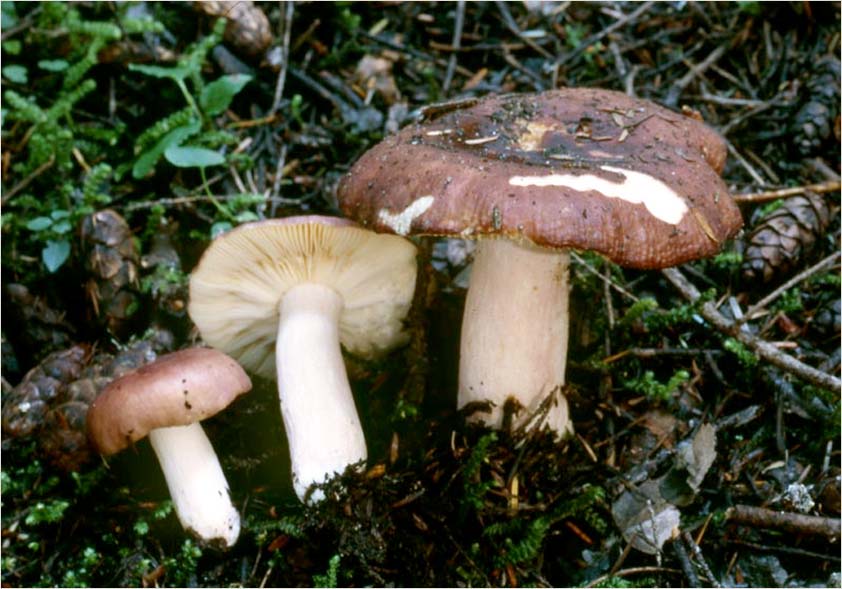
 Brevipes and Compactae Clades - click to expand
Brevipes and Compactae Clades - click to expand
 Fetid Russulas - Ingratula and Crassotunicata Clades - click to expand
Fetid Russulas - Ingratula and Crassotunicata Clades - click to expand
 Heterophyllidia - click to expand
Heterophyllidia - click to expand
 Core Clade - click to expand
Core Clade - click to expand
 Crown Clade - click to expand
Crown Clade - click to expand